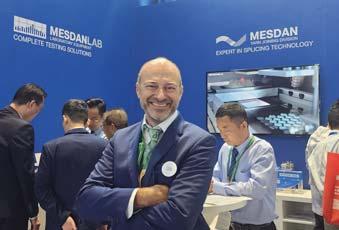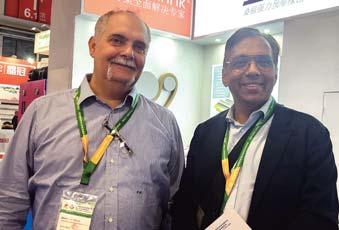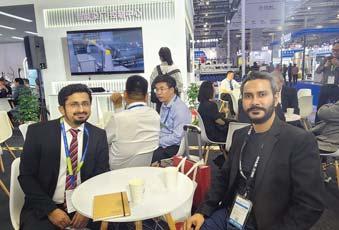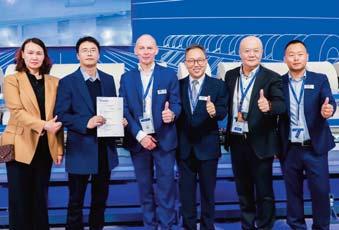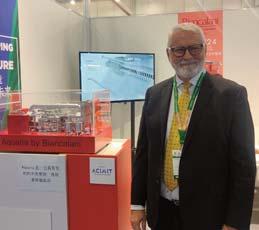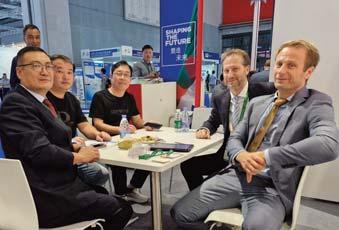









JIAM 2024 OSAKA
Dates: November 27th to 30th 2024.
Venue: Osaka, Japan.

Heimtextil 2025, Frankfurt
Dates: January 14th, to 17th, 2025
Venue: Frankfurt am Main.

FESPA 2025
Dates: January 20th to 22nd 2025.
Venue: Dubai Exhibition Centre.

Apparel Sourcing Paris Autumn
Dates: Feruary 10th to 12th 2025.
Venue: Paris

Istanbul Yarn Fair
Dates: February 13th to 15th, 2025. Venue: Istanbul, Turkey.

Intertextile Shanghai Apparel Fabrics
Dates: March 11th to 13th 2025. Venue: Shanghai, China.

Textile Asia 2025, Karachi
Dates: April 12th to 14th 2025.
Venue: Expo Centre, Karachi.
Textile Asia 2025, Lahore
Dates: November 22nd to 24th 2025.
Venue: Lahore Expo Centre.

DOMOTEX Middle East 2025
Dates: April 22nd to 24th 2025.
Venue: Dubai World Trade Centre.

IGATEX Pakistan 2025, Karachi
Dates: April 24th to 26th 2025.
Venue: Expo Centre, Karachi.

iCADEX Pakistan 2025, Karachi
Dates: April 24th to 26th 2025.
Venue: Expo Centre, Karachi.

FESPA 2025
Dates: May 06th to 09th 2025.
Venue: Messe Berlin in Germany.

DOMOTEX asiaCHINAFLOOR 2025
Dates: May 26th to 28th 2025.
Venue: NECC, Shanghai, China.

ITMA ASIA + CITME, Singapore 2025
Dates: October 28th to 31st, 2025. Venue: Expo Centre Singapore.

Techtextil 2026
Dates: April 21st to 24th, 2026 Venue: Frankfurt, Germany.
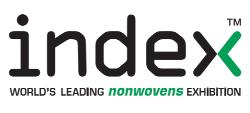
Index 2026
Dates: April 21st to 24th, 2026. Venue: Palexpo, Geneva, Switzerland.
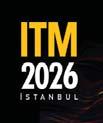
ITM 2026
Dates: June 9th to 13th, 2026. Venue: Istanbul, Turkey.

HIGHTEX 2026
Dates: June 9th to 13th, 2026. Venue: Istanbul, Turkey.

ITMA 2027
Dates: September 16th to 22nd, 2027. Venue: Hanover, Germany.
PAKISTAN TEXTILE JOURNAL - November 2024




Founded in 1951 by Mazhar Yusuf (1924-2009)
Publisher Nadeem Mazhar
Editor in Chief Amina Baqai
Associate Editor
Nimrah Nadeem
Production Manager Mazhar Ali
Layout & Design
Noor M. Jaan
Website / Social Media
Minhaj Ali
Hony-Editorial
Dr. Hafizur Rehman Sheikh Ph.D (UK) F.T.I. (UK)
Syed Mahfooz Qutab C.TEX, F.T.I (U.K), B.Sc. Fellow I.C.T.T Atlanta, GA; (USA)
Dr. Zubair Bandukda PhD (Textiles), CText ATI
Engr. Naeem Ilyas Khanani
Editorial & Advertising Office
B-4, 2nd Floor, 64/21, M.A.C.H, Miran M. Shah Road, Karachi - Pakistan
Tel: +92-21-34311674-5
Fax: +92-21-34533616
Email: info@ptj.com.pk URL: http://www.ptj.com.pk
PTJ Europe Ltd.
Registered Office: Dairy House, Money Row Green, Holyport, Maidenhead, Berkshire, SL6 2ND, United Kingdom.
Registered no. 09141989 Tel: +44 792 2228 721
Available on Gale and Factiva affiliated international databases through Asianet Pakistan
Printed at: Color Plus Korangi, Karachi.
Published by Nadeem Mazhar from D-16, K.D.A. Scheme No.1. Karachi.


















eVent Fabrics signs new talent to meet increasing demand, assist with global expansion into Korea
Rieter places bond for a total of CHF 65 million
Textiles Intelligence partners with the ASBCI to analyse the role of artificial intelligence (AI) in the fashion industry
Officina39 on stage at La Scala Theater for the CNMI sustainable fashion awards . .24


ARCHROMA announces leadership and organizational changes .
Rajiv Sharma assumes the role of Archroma CEO as Mark Garrett transitions to the Board of Directors
Dr. Christian Rink becomes new CFO of the CHT Group
Dr. Christian Rink will take over the position of global CFO of the CHT Group held by Prof. Dr. Klaus Müller on an interim basis
Archroma introduces breakthrough in bio-based textile
Archroma


FESPA Middle East advances regional printing industry through global expertise and reinvestment programme
Functional contract textiles: The multi-talents at
U.S. Cotton Trust Protocol achieves record growth, reinforcing commitment to sustainable practices and traceability
Monforts is 140 and looking to the future
The LYCRA Company publishes its 2023 Sustainability Update, reports on progress versus 2030 goals
Trützschler: Joining forces for Europe’s biggest multi-purpose plant
Trützschler Nonwovens and Texnology to supply complete needle-punching line to O.R.V. Manufacturing S.p.A., Italy
JigMaster – The most gentle and versatile jigger of the industry
Benninger’s high-tech jigger is the perfect choice for demanding dyers
Rieter ring spinning system powers Beste’s fully traceable supply chain
Asia Pacific Rayon (APR) organized its first customer meet in Pakistan . . . . . . . .46
6th DPS World Pakistan 2024: Pakistan’s leading exhibition for digital printing and signage industry
ITMA ASIA + CITME 2024 enjoys strong local attendance .
VDMA companies at ITMA ASIA + CITME 2024: Smart technologies for green textile production
.50




ACIMIT (Association of Italian Textile Machinery Manufacturers) at ITMA ASIA + CITME 2024 in China .
Trützschler and Murata celebrated their partnership at ITMA ASIA 2024
SAVIO showcased its latest automatic winder and air-jet spinning machine during ITMA ASIA+CITME 2024
.55
.56
Successful at ITMA ASIA 2024 – Saurer’s technology highlights . . . . . . . .58
ITMA ASIA + CITME Glimpses 2024





The recent surge in Pakistan's textile exports brings a wave of cautious optimism to an industry vital to the nation's economic health. A 10.44% increase in the first four months of FY25, reaching $6.146 billion, signals a promising trajectory. This growth, coupled with the current economic stability marked by a record-breaking stock exchange, controlled inflation, and a steadied PKR, paints a picture of resilience and potential.
However, it's crucial to acknowledge this growth within the larger context of the challenges that continue to plague the sector. While the overall export figures inspire confidence, a closer look reveals a concerning decline in cotton yarn exports, down by 45.59% in the same period. This disparity highlights the complexities of the textile value chain and the urgent need for a multifaceted approach to sustain and enhance this positive momentum.
One of the most persistent hurdles remains the high cost of production, primarily driven by exorbitant electricity prices. This issue has long cast a shadow over the industry's competitiveness in the global market. Addressing this requires a concerted effort from the government to implement policies that ensure affordable and reliable energy access for textile manufacturers. Investing in renewable energy sources, improving energy efficiency, and rationalizing tariffs are crucial steps in this direction.
Furthermore, diversification of products and markets is essential to mitigate risks and capitalize on emerging opportunities. While the growth in readymade garments and knitwear is encouraging, exploring new avenues within the textile sector, such as technical textiles and non-woven fabrics, can unlock further potential. Similarly, reducing reliance on traditional export markets and actively seeking new partnerships in regions like Africa and South America can enhance resilience and boost export volumes.
The current economic stability provides a fertile ground for implementing muchneeded structural reforms. This includes streamlining bureaucratic processes, facilitating access to finance, and promoting innovation and technology adoption within the textile industry. Investing in skill development and training programs for the workforce is equally important to enhance productivity and meet the evolving demands of the global market.
The government's role in fostering a conducive business environment cannot be overstated. Policy consistency, transparency, and efficient regulatory frameworks are vital to attract investment and encourage sustainable growth in the textile sector. Moreover, promoting collaboration between industry stakeholders, research institutions, and the government can facilitate knowledge sharing, innovation, and the development of a robust textile ecosystem.
In conclusion, the recent surge in textile exports is undoubtedly a positive development, offering a beacon of hope for Pakistan's economic recovery. However, sustaining this growth requires a comprehensive strategy that addresses the persistent challenges of high production costs, market diversification, and technological advancement. By capitalizing on the current economic stability and implementing prudent policies, Pakistan can unlock the full potential of its textile industry and pave the way for sustained economic prosperity.



1
A workshop hosted by the Sustainable Development Policy Institute (SDPI), in collaboration with the United Nations Environment Programme (UNEP) and the European Union, gathered industry leaders and policymakers to develop criteria for Pakistan’s expanding trade in used textiles. The event aimed to lay a foundation for sustainable practices in second-hand textile trade as part of Pakistan’s broader commitment to a circular economy.
2
Pakistan’s textile industry maintained its upward momentum in September 2024, recording a significant 17.9% increase in export earnings compared to last year. Total textile exports

hit $1.605 billion, up from $1.36 billion in September 2023, according to data from the Pakistan Bureau of Statistics (PBS).
3
The Pakistan Textile Exporters Association (PTEA) has identified alarming concerns regarding substantial delays in the disbursement of Rs328.5 billion in refunds, critically affecting the liquidity and operations within the textile industry. Despite multiple government assurances, exporters continue to experience financial strain due to these outstanding refunds, jeopardizing the sector's growth potential.
4
The International Monetary Fund (IMF) has called on Pakistan to promptly eliminate prefer-
1
A recent study titled “Regulatory Framework to Enable Recycling of Post-Industrial Waste (Jhut) for the RMG Industry in Bangladesh,” conducted by GIZ GmbH in collaboration with Swedish retailer H&M, has revealed that Bangladesh is missing out on a lucrative export market worth $4-5 billion annually due to inadequate regulatory frameworks surrounding the recycling of post-industrial textile waste, known as Jhut.
2
India's textile and apparel exports experienced a notable increase of 5.13%, reaching $17.66 billion during the first half of the fiscal year 202425 (April to September 2024). September 2024 was particularly strong, with over-
ential treatment, tax exemptions, and other protective measures for its agriculture and textile sectors, which the organization claims have hindered its economic growth for decades. In a staff report analysing the underlying factors of Pakistan's economic struggles, the IMF highlighted that these sectors not only fail to contribute significantly to national revenue but also consume substantial public funds while remaining inefficient and uncompetitive.
5
In a joint statement, PTEA Patron-in-Chief Khurram Mukhtar and Chairman Sohail Pasha have expressed strong opposition to the government’s decision to halt gas supplies to highly efficient Captive Power Plants
(CPPs) starting January 1, 2025. They warned that this policy change poses a significant threat to the stability and growth of the country’s textile industry, which relies heavily on CPPs for consistent power and operational efficiency.
6
Pakistan is facing a troubling forecast as its cotton import bill for the current fiscal year (FY25) which is projected to soar to $1.9 billion, a significant increase from $448 million last year, according to a report from Arif Habib Limited (AHL). This anticipated rise is largely due to a dramatic drop in local cotton production, which has seen a staggering 48.3% decrease compared to the previous year.

all shipments rising by 12.38%, while apparel exports surged by 17.30%, signalling a robust recovery in the sector following a prolonged period of sluggish foreign trade.
3
In a ground-breaking development for the sustainable fashion sector, researchers in Japan have introduced an innovative decolorization technique aimed at reducing the environmental footprint of textile dyeing processes. This new approach addresses the widespread water pollution and ecological damage linked to the use of synthetic dyes, which have long been a staple in the fashion industry.
4
The UK manufacturing sector experienced a robust increase in pro-
duction volumes towards the end of Q3 2024, according to S&P Global's latest report. Both output and new orders continued to rise, primarily driven by domestic demand.
5
The United States, the largest global apparel importer, saw its apparel imports soar to $79.3 billion in 2023, predominantly from Asian suppliers, according to a recent report by the US International Trade Commission (USITC). This report, requested by the US trade representative, highlights key trends in the apparel import landscape.
6
The Uzcharmsanoat Association from Uzbekistan recently held discussions with Musa Jamanbayev, the Kyrgyz Republic's Ambassador to

Uzbekistan, to explore avenues for expanded cooperation and joint investments in the leather industry.
7
Vietnam's garment exports to the Middle East fell by 25% in the first nine months of 2024, driven by heightened competition and shifting market dynamics. Countries like Bangladesh, India, and Turkey have gained ground by offering competitive prices and a broader range of products, presenting a challenge for Vietnamese exporters. At the same time, economic uncertainties in the Middle East, including fluctuating oil prices and geopolitical tensions, have weakened consumer purchasing power, leading to reduced apparel demand.

A workshop hosted by the Sustainable Development Policy Institute (SDPI), in collaboration with the United Nations Environment Programme (UNEP) and the European Union, gathered industry leaders and policymakers to develop criteria for Pakistan’s expanding trade in used textiles. The event aimed to lay a foundation for sustainable practices in second-hand textile trade as part of Pakistan’s broader commitment to a circular economy.
The workshop, titled “Criteria and Guideline Development for Used Textiles Trade,” addressed the role of Pakistan’s textile industry in global circular trade and underscored the sector's importance. UNEP representative Asad Naqvi emphasized the need to strengthen supply chains from the ground up, beginning with local farmers, while SDPI’s Zainab Naeem pointed out Pakistan’s role as a leading importer of used textiles from the European Union.
With the country’s second-hand clothing imports rising by 17% to over 433,000 metric tons in the past year, the sector’s value has grown significantly, generating over $40 million in revenue. Mustafa Sattar, CEO of Retex Global, shared insights into the recycling process, noting that 90% of clothing is recycled without using water or gas—a vital step towards reducing environmental impact.
The workshop also addressed issues such as microplastic pollution, with UNEP’s Beatriz Fernandez stressing the importance of the textile sector for employment, especially for women, who make up 45% of the workforce. Government officials, including Ministry of Commerce representative Umar

Farooq, highlighted ongoing regulatory efforts to create a sustainable framework for textile trade.
Pakistan’s textile industry maintained its upward momentum in September 2024, recording a significant 17.9% increase in export earnings compared to the same month last year. Total textile exports hit $1.605 billion, up from $1.36 billion in September 2023, according to data from the Pakistan Bureau of Statistics (PBS).
This growth, largely fuelled by demand for finished products, signals a strategic shift within the sector towards exporting higher-value items, while shipments of raw materials, such as cotton yarn, saw marked declines. Readymade garments led the surge, with exports rising by 35%—a standout performance across the sector.
Other finished textile categories also saw impressive gains: knitwear exports

jumped 29.57% to $448.3 million, bedwear rose 24.8% to $290.2 million, and cotton cloth exports increased by 15.33% to $201 million. Exports of towels increased by 7.35%, amounting to $90.55 million.
The strategic shift away from raw materials is evident in the sharp drop in cotton yarn exports, which fell by 54.22% to $52 million. Meanwhile, raw cotton exports plummeted to zero, reflecting the sector’s focus on value addition.
For the fiscal year 2023-24, Pakistan’s textile exports totalled $16.65 billion, showing a modest annual growth of 0.9%. Industry stakeholders see this trend as part of a long-term pivot towards higher-value products, aiming to boost profitability and global competitiveness.
The Pakistan Textile Exporters Association (PTEA) has identified alarming concerns regarding substantial delays in the disbursement of Rs 328.5 billion in refunds, which are critically affecting the liquidity and operations within the textile industry. Despite multiple government assurances, exporters continue to experience financial strain due to these outstanding refunds, jeopardizing the sector's growth potential.
A detailed views of records indicates that the refunds include Rs 55 billion related to sales tax, Rs 105 billion for
deferred sales tax, Rs 25 billion under duty drawback, and Rs 100 billion from income tax refunds. Additional amounts are pending under the Drawback of Local Taxes and Levies (DLTL/DDT), Technology Upgradation Fund (TUF), and markup subsidies.
The PTEA has pointed out that the delays in processing these refunds have worsened liquidity issues, preventing exporters from expanding their businesses and managing increasing financial pressures. The high-interest rates associated with these pending refunds further complicate the situation for textile manufacturers, who play a pivotal role in Pakistan's foreign exchange earnings.
Current regulations, notably the Sales Tax Act of 2006, require refunds to be processed within 72 hours; however, many refunds are now taking over 200 days. For instance, the most recent payments addressed only Refund Payment Orders (RPOs) up to late August, with delays in processing extending well into the fall.
Adding to the concerns, the allocation for DLTL/DDT refunds was only set at Rs 10 billion, significantly lower than the Rs 38 billion liability that exporters claim is due. The PTEA warns that such underfunding restricts reinvestment and growth opportunities, making it difficult for exporters to compete on the global stage.
Although the textile sector has shown a 15% growth month-on-month since August, with exports totalling between $7 to $8 billion, the association cautions that failure to resolve these refund delays could undermine this positive trend. PTEA emphasizes that they are not seeking special treatment, but rather a resolution to the government’s financial commitments.
The International Monetary Fund (IMF) has called on Pakistan to promptly eliminate preferential treatment, tax exemptions, and other protective measures for its agriculture and textile sectors, which the organization claims have hindered the country’s economic growth for decades. In a staff report analysing the underlying factors of Pakistan's economic struggles, the IMF highlighted that these sectors not only fail to contribute significantly to national revenue but also consume substantial public funds while remaining inefficient and uncompetitive.
As part of a recently approved $7 billion Extended Fund Facility, the IMF stressed the importance of moving away from long-standing economic practices to avoid cyclical downturns. The report pointed out that Pakistan's economy is lagging behind similar nations, leading to stagnation and increased poverty levels, with over 40.5% of the population living below the poverty line.
The IMF's findings indicated that Pakistan has not developed a diverse range of sophisticated export goods, with a heavy reliance on agriculture and textiles, particularly in products like cotton yarn, rice, and woven fabrics. Despite exporting some high-value items such as medicines and medical instruments, these sectors operate

under a distorted economic framework, constrained by tariffs on intermediate and final goods, which inhibit competitiveness and growth.
The report noted a significant tax gap in the textile sector, where between 2007 and 2022, it received various subsidies and preferential tax treatments. With 70% of concessional loans from the central bank tied to this sector, the IMF urged the government to simplify trade policies and avoid using tariffs to protect inefficient sectors, warning that such practices lead to resource misallocation.
To enhance economic development, the IMF recommended that Pakistan integrate more effectively into global trade, which would require removing barriers to imports and ensuring a level playing field for businesses. The report suggested that various complex goods could potentially be developed within Pakistan's technological proximity, including chemicals and industrial fabrics, provided that government interventions that lock resources into low-productivity activities are eliminated.
In a joint statement, PTEA Patron-in-Chief

Khurram Mukhtar and Chairman Sohail Pasha have expressed strong opposition to the government’s decision to halt gas supplies to highly efficient Captive Power Plants (CPPs) starting January 1, 2025. They warned that this policy change poses a significant threat to the stability and growth of the country’s textile industry, which relies heavily on CPPs for consistent power and operational efficiency.
The PTEA officials pointed out that substantial investments have been made in gas-based CPPs, with 480 plants connected to the SNGPL network and 800 to the SSGC network. These facilities are essential for ensuring stable and uninterrupted power, which is critical to prevent costly voltage fluctuations that
could disrupt highly automated textile machinery.
The association cautioned that depending solely on the national grid— which is plagued by transmission and distribution losses—would fail to meet the industry's energy demands and risk damaging sensitive equipment across the textile value chain. CPPs allow for the simultaneous generation of power and steam, which is vital for industrial operations, and are deemed more efficient than government-owned plants.
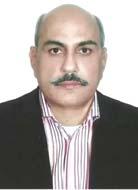
significant losses, with production dropping from 3,452,986 bales in 2023 to 1,916,096 bales in 2024, marking a 44.5% decrease.
Experts attribute this decline to “poor farmer economics and the delayed planting of the cotton crop.” AHL estimates that local production may reach 6 million bales this fiscal year, necessitating the import of approximately 5.4 million bales to meet demand. This heavy reliance on imports poses a significant risk for Pakistan, particularly given that textiles account for over 60% of the country's total exports.
Concerns have been raised about the inadequacy of grid-supplied power, especially given the frequent outages, which could severely hinder industrial productivity. Additionally, large manufacturing units requiring more than 10 MW per hour would face considerable costs and delays if forced to establish their own energy grids, further exacerbating production challenges.
The PTEA also warned that the government’s decision could deepen the financial woes of Pakistan's gas sector, which is already grappling with a circular debt of Rs2,700 billion.
Pakistan is facing a troubling forecast as its cotton import bill for the current fiscal year (FY25) which is projected to soar to $1.9 billion, a significant increase from $448 million last year, according to a report from Arif Habib Limited (AHL). This anticipated rise is largely due to a dramatic drop in local cotton production, which has seen a staggering 48.3% decrease compared to the previous year.
As of mid-October 2024, the Pakistan Cotton Ginners Association (PCGA) reported cotton arrivals totalling 3,101,743 bales, down from 5,996,086 bales recorded on the same date in 2023. The decline is particularly pronounced in key producing provinces. In Punjab, cotton production has plummeted from 2,543,100 bales last year to just 1,185,647 bales this year, reflecting a 53.4% reduction. Sindh has also faced
The situation is further complicated by the potential exacerbation of Pakistan's balance of payment crisis, as rising imports may strain the nation's foreign exchange reserves and complicate efforts to manage external debts.

Kamran Arshad, the newly-elected Chairman of the AllPakistan Textile Mills Association (APTMA) has made a strong appeal to policymakers for urgent reforms to stimulate the struggling sector. Addressing the Association's Annual General Meeting in Lahore, Arshad emphasized the need for a reduction in electricity tariffs and the restoration of the Regionally Competitive Energy Tariff (RCET). He also urged the government to reverse its decision to curtail gas supply to captive consumers starting January 1, 2025, and to include local yarn supply in the Export Facilitation Scheme (EFS).
These initiatives, according to Arshad, are essential to revitalizing the textile sector, driving economic growth, and creating job opportunities. He further advocated for a reduction in interest rates to support industrial expansion.
During the meeting, the election results were announced, confirming Kamran Arshad as the central Chairman, with Muhammad Jameel Qasim as Senior
Vice Chairman and Siddique Javed Bhatti and Shahzad Ahmed Shaikh serving as Vice Chairmen for the 2024-26 term. The Northern Zone also saw a new leadership team elected, including Asad Shafi as Chairman.

Arshad praised the efforts of Dr. Gohar Ejaz, APTMA's Patronin-Chief, for securing member confidence and leading the Association to its 16th consecutive election victory. He highlighted the severe challenges faced by the textile sector over the past year, marked by tight monetary policies, rising energy costs, and political instability, all amid a global economic downturn.
The chairman noted the negative impact of the withdrawal of the RCET in 2023 and energy tariff disparities on the industry, particularly in Punjab. He expressed concern over the misuse of the EFS following the withdrawal of sales tax zero rating on local inputs, which has led to a significant increase in yarn imports.
Dr. Gohar Ejaz, commending the new leadership, expressed optimism about their potential to enhance the country’s export capacity and collaborate with the government to foster a supportive business environment. Asad Shafi, the newly-elected Northern Zone Chairman, encouraged members to invest in the value-added sector to capitalize on Pakistan's demographic advantage, suggesting that such investments could significantly boost exports.
CEM Altan, President of the International Apparel Federation (IAF) at a recent press conference highlighted that Pakistan’s garment and textile exporters must be encouraged to diversify their markets and focus on high-value products. Altan emphasized the importance of exploring emerging markets such as Russia, Central Asia, and the Middle East, moving beyond the current reliance on low-cost textile exports.

During his address, Altan, who represents 42 countries, stressed the need for Pakistani exporters to shift towards value-added offerings like garments, fast fashion, sportswear, and medical wear. He pointed out that the ongoing political instability in Bangladesh presents an opportunity for Pakistan to capture export orders, as global fashion brands seek reliable, compliant production partners.
To remain competitive, Altan urged textile manufacturers to digitize their supply chains by implementing tools like ERP systems, blockchain technology for enhanced transparency, and IoT solutions for better production planning and inventory management. He also called for established brands to bolster their ecommerce platforms and support local manufacturers in accessing global marketplaces such as Amazon, Alibaba, and Etsy.
Ijaz Khokar, former chairperson of the Pakistan Readymade Garment Manufacturers and Exporters Association
(PREGMEA), echoed Altan’s sentiments, indicating that the exploration of new markets, particularly Russia, could yield export values comparable to North America, contingent on establishing banking channels between the countries. He noted an uptick in orders from South Asian buyers and expects this trend to continue.
In an effort to strengthen the local textile industry, PREGMEA is planning to host the World Fashion Convention in Pakistan in 2026, following its successful inaugural event in 2019. Khokar emphasized the necessity of government support in creating research and development centers, textile clusters, and fashion design hubs to enhance the capabilities of garment producers.
With strong interest shown at Texpo Pakistan, Khokar believes this will translate into increased export values. He also suggested that Pakistan should consider launching its own Texpo in Dubai to attract a broader range of buyers.


A recent study titled “Regulatory Framework to Enable Recycling of PostIndustrial Waste (Jhut) for the RMG Industry in Bangladesh,” conducted by GIZ GmbH in collaboration with Swedish retailer H&M, has revealed that Bangladesh is missing out on a lucrative export market worth $4-5 billion annually due to inadequate regulatory frameworks surrounding the recycling of postindustrial textile waste, known as Jhut.
The report emphasizes the urgent need for a comprehensive policy framework to unlock the potential of the largely overlooked informal Jhut sector, which currently captures only 5-7% of the significant waste generated each year. With modest recycling capacity for apparel-grade recycled yarns, Bangladesh is positioned to enhance its recycling efforts substantially.
To address these challenges, the study proposes several critical policy solutions. Establishing a national Jhut database is vital for improving data accuracy and traceability, which will aid better decisionmaking and resource management. The introduction of standardized management and recycling guidelines is also necessary to streamline processes and boost overall efficiency within the sector.
Moreover, the report advocates for revisions to VAT and tariff regulations related to Jhut transactions to create a

more favourable economic environment for recycling activities. Financial incentives are essential to encourage the formalization of Jhut collection, handling, and sorting processes, fostering investment in this sector.
The establishment of cluster-based sorting hubs is recommended to promote decent work, social inclusion, and improved waste management practices. Additionally, enhancing the investment landscape for advanced recycling technologies is crucial for driving innovation and expanding Bangladesh's recycling capabilities.
The findings of the study highlight the critical need for policymakers to implement these recommendations to capitalize on the economic, social, and environmental benefits of a formalized Jhut recycling industry. As Bangladesh aims to position itself as a leader in sustainable textiles, these reforms could

significantly strengthen its economy while promoting a circular textile economy.

India's textile and apparel exports experienced a notable increase of 5.13%, reaching $17.66 billion during the first half of the fiscal year 2024-25 (April to September 2024). September 2024 was particularly strong, with overall shipments rising by 12.38%, while apparel exports surged by 17.30%, signalling a robust recovery in the sector following a prolonged period of sluggish foreign trade.
In detail, textile exports grew by 2.76% to $10.155 billion, compared to $9.882 billion during the same period last year. Apparel exports also rose significantly, up 8.51% to $7.505 billion, from $6.916 billion in the previous fiscal year. As a result, the share of textiles and apparel (T&A) in India's total merchandise exports increased to 8.28%, according to the Ministry of Commerce and Trade.
Key sectors within textiles saw varied performance: exports of cotton yarn, fabrics, made-ups, and handloom products experienced a modest rise of 0.79% to $5.946 billion. Man-made yarns, fabrics, and made-ups grew by 2.95% to $2.405 billion, while carpet exports rose by 11.41% to $745.74 million.
In September 2024 alone, T&A exports amounted to $2.923 billion, with textile exports increasing by 9.56% to $1.813 billion, and garment shipments seeing a significant rise to $1.110 billion from $946.35 million in September 2023. Under textiles, exports of cotton yarn, fabrics, made-ups, and handloom products rose by 3.48% to $1.053 billion, while man-made products surged by 11.41% to $415.28 million.
On the import side, India witnessed an 18.74% increase in raw cotton and waste imports, totaling $477.38 million, alongside a 3.45% rise in imports of textile yarns, fabrics, and made-ups. However, imports of textile yarn, fabrics, and made-ups decreased by 1.80% in September 2024.
Despite a decrease in the previous fiscal year, where total textile and apparel exports fell by 3.24% to $34.43 billion, industry leaders are optimistic about the upward trend. Sudhir Sekhri, chairman of the Apparel Exports Promotion Council (AEPC), highlighted India's unique position in the global market, attributing the growth to low import intensity, a comprehensive ecosystem and a young labour force.

In a ground-breaking development for the sustainable fashion sector, researchers in Japan have introduced an innovative decolorization technique aimed at reducing the environmental
footprint of textile dyeing processes. This new approach addresses the widespread water pollution and ecological damage linked to the use of synthetic dyes, which have long been a staple in the fashion industry.
By employing advanced methodologies, the team has effectively extracted dyes from various fabrics without sacrificing their integrity. This enhancement not only curtails the negative environmental effects associated


with textile production but also significantly improves the feasibility of recycling worn garments. By streamlining the decolorization process, the researchers are promoting a circular fashion model that emphasizes reuse and repurposing, thereby minimizing waste.
The potential impact of this research is far-reaching. As consumers increasingly prioritize sustainability in their purchasing decisions, fashion brands that implement environmentally conscious practices are likely to attract a more discerning clientele. This shift could catalyse a broader transformation in manufacturing practices within the industry, steering it toward greener alternatives.
As the global emphasis on sustainability intensifies, this pioneering decolorization method stands to significantly influence the textile industry, advocating for both ecological integrity and economic sustainability. The findings signal a hopeful trajectory for responsible fashion, setting the stage for a cleaner, more sustainable future in textiles.

The UK manufacturing sector experienced a notable increase in production volumes towards the end of Q3 2024, according to S&P Global's latest report. Both output and new orders continued to rise, primarily driven by domestic demand.

However, the anticipation of the upcoming Autumn Statement has led to a more cautious approach among manufacturers, resulting in slower growth in production and new business, alongside a decline in future expectations that have dropped to a nine-month low.
The seasonally adjusted S&P Global UK Manufacturing Purchasing Managers' Index (PMI) registered at 51.5 in September, down from August’s 26month high of 52.5, marking five consecutive months above the neutral threshold of 50. Three of the five PMI sub-components—output, new orders, and suppliers' delivery times—indicated favourable operating conditions for manufacturers.
Conversely, employment levels and purchase stocks decreased, as firms sought to control rising input costs by cutting expenditures elsewhere. September marked the fifth month of rising manufacturing production as businesses adapted to increased new orders.
Despite the overall growth, there was a notable decline in new export business for the thirty-second straight month,

attributed to lacklustre market conditions in Europe, particularly concerning demand from France and Germany. Lower orders from U.S. clients also contributed to this trend.
The month saw heightened uncertainty affecting manufacturers and their clients, reflected in slower growth in new orders and output compared to August. Business confidence regarding future production fell to its lowest point in nine months, with the decline in the future output index marking the secondlargest drop on record since March 2020.
Concerns over potential government policy changes, particularly surrounding October’s Autumn budget, combined with subdued global market conditions, are dampening the outlook for the next year. Nevertheless, about half of those surveyed—down from over 60% in August—still anticipate increased output, motivated by new projects and planned product launches.
September also witnessed a decrease in manufacturing employment following two months of increases, while input prices rose at their fastest rate since January 2023.

The United States, the largest global apparel importer, saw its apparel imports soar to $79.3 billion in 2023, predominantly from Asian suppliers, according to a recent report by the US International Trade Commission (USITC). This report, requested by the US trade representative, highlights key trends in the apparel import landscape.
Among the notable suppliers, Bangladesh, Cambodia, India, Indonesia, and Pakistan ranked in the top 10 apparel exporters to the US, collectively accounting for 27% of the country’s apparel imports last year. Over the past decade, the market shares of these suppliers have shifted significantly. While China, the leading exporter, experienced a decline in its share, Vietnam, Bangladesh, Cambodia, and Pakistan saw their shares rise.
Bangladesh, as the second-largest apparel exporter globally, excels in manufacturing basic garments in bulk, thanks to its low labour and input costs, along with duty-free access to key markets outside the US. Cambodia's apparel sector thrives on foreign direct investment and focuses on cut, make, and trim production, utilizing imported materials. Its commitment to social responsibility further enhances its appeal as an alternative sourcing option to China.
India stands out for its high-quality production, characterized by detailed finishing and a vertically integrated industry. In contrast, Indonesia, although a higher-cost supplier, specializes in highvalue garments such as business attire and athletic wear. Lastly, Pakistan leverages its strong cotton sector to support its apparel industry, particularly in producing high-quality denim, though geopolitical risks remain a concern for buyers.

Discuss
The Uzcharmsanoat Association from Uzbekistan recently held discussions with Musa Jamanbayev, the Kyrgyz Republic's Ambassador to Uzbekistan, to explore avenues for expanded cooperation and joint investments in the leather industry. During the meeting, the two sides assessed the current state of bilateral relations in the sector, evaluating past efforts and setting new priorities. Ambassador Jamanbayev expressed interest in learning from Uzbekistan's

advancements in leather production and suggested collaborative projects involving Uzbekistan’s key industry players in Kyrgyzstan.
Discussions also covered potential partnerships in wool processing and raw leather collection, with Jamanbayev highlighting Kyrgyzstan's need for improved leather processing capabilities to reduce wastage.
As a result, both parties agreed to establish a platform to facilitate business tours and negotiations, enabling entrepreneurs from both nations to foster stronger ties in the leather sector.

Vietnam's garment exports to the Middle East fell by 25% in the first nine months of 2024, driven by heightened competition and shifting market dynamics. Countries like Bangladesh, India, and Turkey have gained ground by offering competitive prices and a broader
range of products, presenting a challenge for Vietnamese exporters. At the same time, economic uncertainties in the Middle East, including fluctuating oil prices and geopolitical tensions, have weakened consumer purchasing power, leading to reduced apparel demand.
Industry experts attribute this downturn not only to increased competition but also to a shift in consumer spending habits in the Middle East, where retailers have responded to economic pressures by tightening budgets and scaling back on orders from Vietnamese suppliers.
In light of these developments, Vietnamese garment leaders are urging manufacturers to innovate, focusing on sustainability, quality improvements, and supply chain efficiency to regain market share. Diversifying export destinations and strengthening partnerships within the Middle East are also seen as crucial strategies for maintaining resilience and adapting to the evolving global apparel market.
The decline signals the need for Vietnam’s garment industry to adopt a forward-thinking approach, emphasizing adaptability and strategic planning to navigate an increasingly competitive environment.


New Senior Sales Manager, Textile Engineer, and Korean Market Consultant bring key skills to industry-leading brand
eVent® Fabrics, a global leader in waterproof and breathable laminates, is proud to announce the recent hiring of three key team members to assist with growing demand for the brand’s expanding line of performance laminates and recent expansion into the South Korean market.
Recent hires include Bartosz Lassak to the US sales team and Xie Yi to engineer the next generation of eVent textiles. For the recent expansion into Korea, Terry Kim will assist as eVent’s Korean Market Consultant.
“We are taking a range of steps now to position eVent for future growth. Our newest hires and work in the Korean market are just two of our most recent efforts to meet increasing global demand,” said Chad Kelly, President of eVent Fabrics. “Additionally, with increasing regulatory pressures and elevated consumer demand for PFAS-free technologies such as our alpineST and BIO laminates, we are well positioned for future success.”
eVent’s recent expansion into the Korean market includes a new strategic partnership with GEO International Co., LTD, a leading Korean company in the textile industry. This collaboration will introduce eVent’s high-performance waterproof breathable laminate solutions for apparel, footwear, and accessories to the Korean market, catering to the increasing demand for premium outdoor and performance apparel.
eVent’s newest team members include:
Based in Washington D.C., Bartosz is a Senior Sales Manager for the Eastern U.S. region and will help expand eVent’s sales footprint as new customers are added to the eVent portfolio. Bartosz brings 20 years of global industry experience and has a deep knowledge of outerwear materials, end use applications, and component brand sales. Most recently, Bartosz was a Territory Sales and Marketing Manager for Primaloft, managing ingredient brand distribution in the UK, Germany, Eastern Europe, Russia, Turkey, and North America.
Having recently graduated with a double Master’s Degree in Textile Materials and Product Design from the highly regarded Donghua University, Xie joins the eVent team full time as a Textile Engineer. Xie will be integral as eVent continues to enhance product strategy and new product introductions. Throughout her academic career, Xie worked as a Production Assistant for Oya Jacquard Belt limited and a Research and Development Assistant at Atelier LUMA. Terry Kim – Senior Consultant in Korea
Terry will support the expansion of eVent’s global footprint into Korean markets and assist with marketing efforts in the Korean market as well. Terry has significant experience in the industry including 20 years working in roles such as Sales Director and New Business Development Director in his time at Gore-Tex. In his most recent role, Terry was the Managing Director of Fabric Division for Gore-Tex.


WEKO is the official sales & service partner in North America for PLEVA Sensors and Controls. Mr. Terence McGee (General Manager WEKO North America) and his team represent PLEVA in the USA and Canada.
After a successful technology training at PLEVA headquarters Empfingen in Germany, Terence McGee (General Manager WEKO North America) and Daniel Forbes (Service Technician) are ready to support and advise the customers in USA and Canada.
WEKO is worldwide known for high quality minimal spray dyeing and finishing technology. This in combination with PLEVA high precision sensors and controls will give many advantages in terms of improving efficiency and sustainability in industrial production. Significant reduction in water, energy and chemical consumption can be achieved. In addition, new functional effects can be created for technical textiles, paper, nonwovens and more.
“WEKO is a great partner for us. We are looking forward to the co-operation in North America and are ready to start new, exciting projects. Together we make the industry more sustainable.” states Kathrin Pleva, Member of Management.
As a starting point, PLEVA and WEKO presented themselves together on a common exhibition booth at Techtextil North America, which took place from 20 to 22 August in Raleigh, North Carolina.
Rieter Investor Update 2024Order intake of CHF 226.4 million in the third quarter, CHF 629.8 million after nine months
Sales of CHF 163.3 million in the third quarter, CHF 584.3 million after nine months
Order backlog of around CHF 690 million as of September 30, 2024 Outlook for the full year 2024
The market environment in the reporting period was characterized by restrained investment in new machinery in almost all regions except China. Demand for consumables, wear & tear and spare parts weakened slightly due to the low spinning mill capacity utilization. The noticeable downturn in consumer sentiment had a further dampening effect throughout the entire textile value chain.
Despite this challenging market environment, the Rieter Group recorded a gratifying order intake of CHF 629.8 million in the first nine months of 2024 (2023: CHF 452.2 million) in all market regions. In the third quarter of 2024, orders increased by 78% year-on-year to CHF 226.4 million (2023: CHF 127.2 million). This means that the order intake has increased for the third quarter in a row.
Rieter’s cumulative sales in the first nine months of 2024 amounted to CHF 584.3 million (2023: CHF 1 092.9 million), a decrease of 47% compared to the prior-year period. Sales in the third quarter of 2024 were CHF 163.3 million (Q3 2023: CHF 334.7 million).
The Business Group Machines & Systems generated total sales of CHF 264.1 million in the first nine months of 2024 (-65% compared to the same period of the previous year). The Business Group Components posted sales of CHF 184.5 million, 11% lower than in the corresponding period of the previous year, while the Business Group After Sales recorded a slight decline of -1% to CHF 135.7 million in the first nine months of 2024.
As of September 30, 2024, Rieter has an order backlog of around CHF 690 million (September 30, 2023: CHF 900 million).
The transfer of resources and responsibilities to India and China to
enable the key markets to respond in a more agile way to customer needs and cycles in the machinery business is on track. The planned cost savings were achieved. Rieter continues to consistently implement the action plan to increase profitability.
Due to the overall geopolitical situation and the general deterioration in consumer sentiment, the market recovery is proving to be more restrained than previously forecast. The first signs of a recovery in financial year 2024 have emerged in the key markets of China and India.
For the full year 2024, Rieter now anticipates sales in the range of CHF 900 million and an EBIT margin remaining at 2% to 4%.
Rieter has today placed a bond of CHF 65 million with a term of five years and a coupon of 3.5%. The net proceeds of the issue will be used for general corporate purposes. “The bond also extends the maturity profile of our debt financing and increases the diversification of the investor base as well as our strategic flexibility,” said Oliver Streuli, Rieter Group CFO.
The bond was issued by UBS, Zürcher Kantonalbank, Commerzbank and Basler
Kantonalbank. The bond will be listed on the SIX Swiss Exchange.
Rieter is the world’s leading supplier of systems for manufacturing yarn from staple fibers in spinning mills. Based in Winterthur (Switzerland), the company develops and manufactures machinery, systems and components used to convert natural and man-made fibers and their blends into yarns in the most cost-
efficient manner. Cutting-edge spinning technology from Rieter contributes to sustainability in the textile value chain by minimizing the use of resources. Rieter has been in business for more than 225 years, has 18 production locations in ten countries and employs a global workforce of around 4 800, about 16% of whom are based in Switzerland. Rieter is listed on the SIX Swiss Exchange under ticker symbol RIEN.

Textiles Intelligence is the official media partner of a forthcoming industry conference which will analyse the challenges and opportunities of artificial intelligence (AI) in the textiles and clothing industries. The conference is being hosted by the Association of Suppliers to the British Clothing Industry (ASBCI) and it will take place in Halifax, UK.
AI tools are poised to disrupt the entire fashion value chain—from trend prediction, product development and stock optimisation to personalised marketing, customer journeys and retail design.
In particular, they are set to drive innovation, create competitive advantages, give rise to new risks and raise ethical questions as to how this new technology can be exploited.
The ASBCI conference will explore how the textile and clothing industries can harness the rewards of AI while mitigating the risks and fulfilling its responsibilities to businesses, people and the planet.
At the conference, technologists, experts at the forefront of AI innovation and retailers pioneering AI tools will provide use cases, highlight the potential benefits, and consider the legal, ethical and sustainability risks associated with AI innovations.
The keynote presentation will be delivered by Dr Ahmed Zaidi, a visiting AI researcher at the University of Cambridge and the chief executive officer (CEO) and co-founder of Hyran Technologies—an AI platform which helps brands and suppliers respond to consumer demand, increase profitability and reduce waste.
Dr Zaidi will address how AI can help the textile and clothing industries to meet their core, long-standing challenges by exploring the intersection of fashion and AI.
Jack Stratten—the head of trends at the retail trendspotting agency Insider Trends—will provide an overview of innovation and AI in retail and will highlight the positives and negatives of AI in the real world and in real time. Insider Trends works with a number of major retail brands—including Galleries Lafayette, Tommy Hilfiger and Westfield—to identify the key trends in retail.
Nick Eley, the head of digital creation at ASOS, will provide the retailer’s perspective on the rise and integration of AI in product design and presentation. He will explain how the use of three-
dimensional (3D) software, AI and emerging technology is driving innovation and efficiencies at ASOS, enhancing creativity, streamlining workflows and reducing time to market.
The power of AI to improve real-time supply chain transparency and actionable insights will be explored by Cedric Hoffman, the co-founder of the AIpowered supply chain platform Ameba. He will highlight how AI can automatically extract and structure relevant product and supplier information from existing communication flows and how this is helping businesses to improve their operational efficiencies and make space for innovation and growth. And Andrew Dalziel, from software provider Infor, will consider how AI could revolutionise areas such as demand prediction and inventory optimisation in order to enhance the customer experience.
Focusing on the creative process, Peter Gallagher-Witham and Jon Smith, the co-founders of The Fashion Guild, will explore the benefits and threats of AI in the design process and share their experiences of AI image generation
software—asking whether it will lead to revolution or redundancy.
Personalisation expert Sarah McVittie, from Dressipi, will explain how harnessing AI insights can help brands and retailers to combat overproduction. Ms McVittie is passionate about reducing the terminal stock waste which results from overproduction. She will explore the size of the waste problem, the changes required, and how to achieve the changes using AI tools.
Linked to this problem is AI’s potential to tackle another intractable industry issue—size and fit. Jason Wang, the chief operating officer of Alvanon, has been pivotal to the company’s AI developments in this field, and he will share his expertise on how emerging technologies can help brands and retailers to cater better to their customers’ fit requirements.
Meanwhile, Norv Bell, the founder of The Bureau model agency, will discuss AI’s legal minefield when it comes to intellectual property rights and HR, and Simon Platts—the co-founder and board advisor at Recomme.co and an ASBCI director—will share his expertise on the
use of AI along the supply chain, and in sustainability and double materiality assessment.
Further exploring the sustainability angle will be James Omisakin, the cofounder of Compare Ethics— an organisation which deals with issues that include the environment, human rights, compliance, and AI technology.
Two panel discussions—moderated by Jenny Holloway from Fashion-Enter and Simon Platts, respectively—will consider the risks, rewards and responsibilities of generative AI and AI for data analysis.
Announcing the conference, the chair of the ASBCI, Julie King, said: “Understanding the risks and potential of AI is a key priority for the fashion industry and one that touches on so many of the challenges our members are facing.
“But with so many tools under the AI umbrella, and such rapid and far-reaching change, it can be challenging to keep on top of developments and cut through the noise to understand what we should and should not be doing, when and how. This conference is an unmissable opportunity to explore the topic from all angles and perspectives at what is a pivotal moment for the industry.”

A prestigious recognition for the Biella-based company and its product Recycrom™, the dyestuff derived from textile waste that allows fashion brands to responsibly dye their garments.
One might say that La Scala Theater has seen it all over its centuries-long history, but it is safe to say that this is the first time a dye made from only textile scraps has been in its spotlight. In fact, in Milan’s most famous theater, on the evening of Sunday 22nd September 2024, Officina39 took part in the Sustainable Fashion Awards 2024 organized by the Camera Nazionale della Moda Italiana. Despite not winning, the company, founded in 1992, was nominated among the three finalists of the Groundbreaking Award with its patented dye Recycrom™
Inspired by Italian craftsmanship and creativity, Officina39 researches and develops sustainable chemicals for the textile, apparel and denim industries, creating technologies with low environmental impact, reducing the use of resources and raw materials. Six years ago, these goals led to the creation of Recycrom™, a range of pigment powders derived 100% from used clothing, fibrous material, and textile scraps through a patented mechanical upcycling process. These fibers produce exceptionally even dyes that can be used on fabrics and garments made of cotton, wool, nylon, or other natural and synthetic fibers, either by dyeing, printing, coating, or spraying.
Participating at the CNMI Sustainable Fashion Awards 2024 is a recognition that rewards the efforts of Officina39. The company has been developing and improving this technology for years by working closely with brands, which often provide the garments to be recycled for unique, custom-made dyes. Blue of a Kind, Calvin Klein, Flavia La Rocca, G-Star Row, H&M Group, OVS, Pangaia, Stella McCartney, Tommy Hilfiger are just some of the partners who have joined the Recycrom™ journey.
To make this color revolution even more accessible and impactful to the

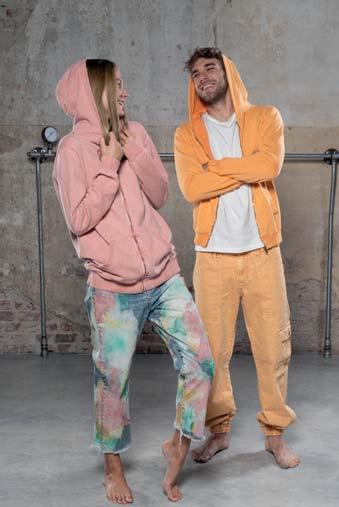
market and the industry, last year Officina39 also launched Recycrom™ Ready to Dye, a range of 15 ready-instock colors made from a minimum of 65% recycled pre- and post-consumer textile materials, offering brands the ability to choose and create their own dyes from a standard color chart.
Moreover, Officina39 is, for all its purposes, a laboratory and workshop

where new solutions are experimented every day to meet the needs of fashion and the environment. Here, the key word is Trustainable, a mix of passion, innovation, sustainable practices, transparency and social responsibility. The CNMI Sustainable Fashion Awards 2024 is a milestone to remember in Officina39’s journey, but the path to a less impactful industry is still long and full of innovation.

Rajiv Sharma assumes the role of Archroma CEO as Mark Garrett transitions to the Board of Directors
Archroma, a global leader in specialty chemicals towards sustainable solutions, has announced that Rajiv Sharma has been appointed as the new Chief Executive Officer (CEO) with key responsibility for the Textile Effects business, effective October 1, 2024. Current Group CEO Mark Garrett will transition to the Archroma Board of Directors.
Miguel Kohlmann, Chairman of the Board of Directors of Archroma, said: “We would like to thank Mark for his strategic leadership throughout a period of transformation and for enhancing the company’s growth trajectory. Mark brings a great deal of expertise and experience to the Board and joins us in welcoming Rajiv Sharma. In Rajiv, we have an inspiring global leader with proven experience in delivering long-term growth.”
“It has been an honor to lead Archroma at such an exciting time, as the company has delivered substantial growth in sales and profitability and successfully integrated the Huntsman Textile Effects business. We have become the clear market leader, with the most comprehensive set of solutions to support our customers in helping reshape our industry for a more sustainable future,” Mr. Garrett said. “Rajiv is a proven visionary with a track record of generating global growth through sustainability, innovation and sound financial management. He is the ideal leader for a forward-looking company with roots that go back more than two-and-a-half centuries.”
Rajiv Sharma comes to Archroma following a 14-year tenure with Coats Group plc (LSE: COA.L), where he was Group Chief Executive for the last eight years. As head of the UK-listed company, which is the world leader in thread manufacturing and structural components for apparel and footwear, Mr. Sharma created a platform for profitable growth

and shaped a company culture based on customer centricity, innovation, digitalization and sustainability.
“I feel very privileged to be given the opportunity to lead this dynamic business at a pivotal time of transformation,” Mr.
Sharma said. “We have an incredible opportunity to support the textile and apparel industry on a sustainability journey that will redefine what’s possible and touch the lives of people all around world.”
Barry Siadat, Archroma Board member and co-Founder of SK Capital Partners, said: “Rajiv brings an ideal set of experience which will support Archroma as it continues to play a key role as the global leader in color and specialty textile chemicals with the industry’s broadest product portfolio and expertise in manufacturing, research and technology, operations and technical customer support that spans the globe. In addition to welcoming Rajiv, we wholeheartedly thank Mark Garrett for the instrumental role he played in serving the company by executing Archroma’s successful acquisition and integration of Huntsman Textile Effects and for delivering substantial growth for Archroma. We are also grateful for his ongoing service as an active Board Member.”
In parallel with these leadership changes, Archroma’s Packaging Technologies business is established as a focused business activity from October 1, 2024, with the aim of increasing its focus on the packaging business and accelerating its development. It will continue under the proven leadership of its CEO, Sameer Singla, who will report directly to the Archroma Board of Directors. Packaging Technologies has also delivered substantial growth with more dedicated leadership over the past two years and the organizational changes will help both Textile Effects and Packaging Technologies continue to focus on best serving their respective customers and markets.
Archroma is a global, diversified provider of specialty chemicals serving the branded and performance textiles,
packaging and paper, and coatings, adhesives and sealants markets. Headquartered in Pratteln, witzerland, Archroma operates with more than 5,000 employees located in 42 countries and with 35 production sites.
Archroma is passionate about delivering leading and innovative solutions, enhancing people’s lives and respecting the planet. The company is committed to the principles of "The Archroma Way to a Sustainable World: Safe, Efficient, Enhanced. It's our nature!"; an approach reflected in its innovations, world-class quality standards, high service levels and cost-efficiency.

Dr. Christian Rink will take over the position of global CFO of the CHT Group held by Prof. Dr. Klaus Müller on an interim basis.

Dr. Christian Rink will form the Management Board together with CEO Eva Baumann. In this role, he will be responsible for Finance & Controlling, Information Technology, Digitalization, Compliance Management and Project Management.
Dr. Rink has gained extensive experience in various functions within the Bosch Group, where he held management positions in Logistics and Finance & Controlling. Among other things, he was Commercial Head Asia Pacific for the Bosch Home Comfort Group in Shanghai, China, and most recently Vice President Finance and Controlling of the Business Unit Electric Solutions which was responsible for building up the Bosch Group's heat pump business.
Eva Baumann comments: “We are firmly convinced that Dr. Rink will make an important contribution to the future success of the company and the achievement of our goals in this crucial position. On behalf of the entire
workforce, I would like to welcome Dr. Christian Rink to the Management Board!”
Johan de Ruiter, Chairman of the Foundation, is certain: “With Dr. Christian Rink, we have appointed a CFO for the CHT Group who will lead the company into a successful future. His many years of experience as CFO of another foundation-managed company and his diverse activities in the industry make him the ideal choice. In these challenging times, we are confident that this will secure and further expand the long-term success of the CHT Group.”
“The Management Board has big plans for the future,” confirms Eva Baumann and clarifies: “We are facing challenging but promising times of change. As a company owned by two foundations, we have strong backing. Nevertheless, we bear a great responsibility for the continued existence of the company and for our employees worldwide. As a manufacturer in the chemical industry, we want to further establish and expand our leading role in
the field of sustainability in the future. With Christian Rink, we form an ideal team to realize our ambitious plans.”
Dr. Christian Rink supplements:
“Together with Eva Baumann, our Management team and the entire workforce, we will continue to expand the CHT Group as a successful and profitable group of companies in the specialty chemicals sector. Prof. Dr. Klaus Müller has shown exemplary commitment and a great sense of responsibility for the CHT Group over the past months as interim CFO. With competence, vision and empathy, he has made a decisive contribution to creating stability and preparing CHT for its future tasks in the best possible way. I would like to express my sincere thanks to him for this.”
The CHT Group pursues important corporate principles: a value-based corporate management, a high level of innovation and a continuous commitment to sustainability.


Utilizing renewable materials* and formaldehyde-free chemistries, the industry-first Archroma NTR Printing System combines newly created pigment black and customized auxiliaries for enhanced sustainability, comfort and durability
Archroma, a global leader in specialty chemicals towards sustainable solutions, has introduced the NTR Printing System to make bio-based pigment printing commercially possible for the first time. Based on renewable raw materials* and designed for safer chemistry, it helps apparel and textile brands reduce their environmental footprint while producing brilliant black shades on garments that deliver both comfort and durability.
Bio-based pigment printing is an emerging technology that is attracting major interest from brands that want to use pigments derived from natural sources, such as plants, in the production of environmentally conscious textiles. Until now, however, bio-based pigments have not delivered color fastness that is comparable to synthetic pigments, and color quality and production performance have not been sufficient to support commercial-scale production.
Archroma’s NTR Printing System is the first to utilize renewable feedstock* across pigment dispersion, binder and fixing agent. Crucially, it ensures good wet-rubbing and dry-rubbing fastness, with outstanding softness on all kinds of fabrics. Furthermore, it is suitable for most popular application technologies, including printing, coating and
continuous pigment dyeing, with outstanding runnability for production efficiency.
“These properties make the new NTR Printing System ideal for the highly competitive denim market, where sustainability, comfort and durability are important; for knits, where very soft handfeel is essential; and on babywear, where both exceptional softness and safety are required,” Joaquin Femat, Market Segment Director for Printing, Archroma, said.
“This latest breakthrough is another example of innovation under Archroma’s “PLANET CONSCIOUS+” roadmap. We develop revolutionary products, systems, and technologies with increased sustainability features than available market alternatives and enhanced value so that brands and mills can differentiate themselves with solutions that meet their business goals and sustainability targets,” he continued.
The result of more than two years of research and development, the innovative new NTR Printing System required Archroma to create customized binding and fixing agents to ensure fastness for the pigment black dispersion comparable to current petroleum-based printing systems. All three printing elements are partially based on renewable feedstock to reduce reliance on non-renewable petrochemicals. Archroma also developed the new system to avoid toxic input streams and impurities, including formaldehyde. Two successful bulk trials were conducted with Textprint S. A. and Jeanologia.
The NTR printing system comprises the following highly efficient and robust printing elements:
PRINTOFIX® BLACK NTR-TF: A nongelling pigment black with 79% renewable carbon content**, designed for use in textile applications with no impact on fastness levels.
HELIZARIN® NTR-SS: A formaldehyde-free super-soft binder with 40% renewable carbon content**, designed to ensure very good overall fastness levels.
FIXING AGENT NTR-HF: A formaldehyde-free fixing agent with 40% renewable carbon content**, designed for high wet fastness in rubbing and laundry.
All three elements are currently being evaluated for compliance with globally accepted standards like bluesign®, the Global Organic Textile Standard (GOTS) and Zero Discharge of Hazardous Chemicals (ZDHC). The system also supports major industry restricted substances list (RSL) requirements.
“With the launch of the bio-based NTR Printing System, Archroma can now draw on the industry’s most complete portfolio of innovative printing solutions to tailor systems for individual customer needs,” Mr. Femat said. “We remain the global leader in pigment printing, with a history of innovation that includes the first formaldehyde-free pigment printing system, introduced in 2012.”
* The NTR printing system utilizes partially renewable raw materials.
**Based on ASTM D6866 bio-based product testing using radiocarbon analysis.
Deeper commitment to innovation and partnership; sharper focus on consumers and the environment
Archroma, a global leader in specialty chemicals towards sustainable solutions, has honed its vision of the future of the apparel and textile industry with the announcement of “PLANET CONSCIOUS+”, a roadmap designed to support brands and mills to chart their sustainability journey.
“Over the past decade, Archroma has been on a mission to lead the textile industry towards a more sustainable future. But the world’s challenges are escalating – from climate change to economic and geopolitical instability. We believe that the time is right for us to realign our vision to guide the next phase of our development. ‘PLANET CONSCIOUS+’ encapsulates both our responsibility and our potential as a company that touches and colors people’s lives every day, all around the world,” Mark Garrett, Group CEO, Archroma, said.
“With the industry’s most extensive product portfolio and a comprehensive global footprint, Archroma has the resources and drive to go beyond the status quo and advance what’s possible for apparel and textile brands on multiple fronts at the same time,” Paul Cowell, Vice President of Innovation, Marketing, Brand Engagement and Sustainability for Archroma Textile Effects, explained. “The introduction of ‘PLANET CONSCIOUS+’ deepens our commitment to innovation and partnership and sharpens our focus on consumers and the environment to bring about meaningful change with pace and at scale.”
“PLANET CONSCIOUS+” has six dimensions, the first four of which have been rolled out over the past few months:
SUPER SYSTEMS+: Powerful end-to-end systems that combine processing solutions and intelligent effects, SUPER SYSTEMS+ deliver measurable environmental impact, more durable colors and effects, and cleaner chemistry as compared to the current market offering. This allows brands and mills to select the impact they want to achieve in line with their sustainability goals.
SAFE EDGE+: Groundbreaking initiative represents a major commitment to providing a roadmap for compliance and cleaner chemistries for use in the textile industry by combining The Safe Edge platform with Foundation+. Foundation+, Archroma’s beyond-compliance portfolio, is a curated selection of Archroma products that utilize innovative technologies to either design out hazardous or regulated substances or reduce them by more than 95% compared to the current industry standard limits.
ONE WAY+: Combining Archroma’s One Way Impact Calculator, a world-first online tool for sustainable value chain mapping, with its expert-led Sustainability Improvement Program (SIP), ONE WAY+ helps mills and brands overcome their specific challenges with products and tools that offers the highest operational excellence and productivity, achieves savings of resources such as water, energy, and creates differentiation with value-added end-products.

COLOR MANAGEMENT+: An advanced color design and development solution, COLOR MANAGEMENT+ helps mills and brands work together for improved sustainability. It incorporates the industry’s largest off-the-shelf color atlas selection alongside color standards created with Archroma’s SUPER SYSTEMS+ for reduced environmental impact and consistent and accurate color reproduction.
The remaining two pillars of “PLANET CONSCIOUS+” are being introduced now that continuesto underscore that innovation and transparency are the cornerstones of the Archroma way of working.
INNOVATION+: Archroma brings together science, their technological expertise and in-depth market, customer, and regulatory knowledge to create groundbreaking solutions that have a positive environmental impact. To accelerate the shift to a circular economy and help manufacturers use resources more efficiently, Archroma’s research and development teams across Americas, Asia and Europe focus on innovating for cleaner chemistry and durable effects.
COMMUNICATION+: By providing authentic, fact-based information to all stakeholders, Archroma helps improve transparency across the value chain. This enables mills and brands to communicate their sustainability goals and achievements with confidence and navigate issues like regulatory complexity and consumer skepticism.
“To truly make a difference in our fast-paced world, innovation must be accompanied by accountability and trust. We work with brands and manufacturers to develop and produce end-products that are safer than available market alternatives and made in a more sustainable and efficient way— and we give them the tools to measure their environmental impact and talk about their contribution with evidence-backed data,” Mr. Cowell said.
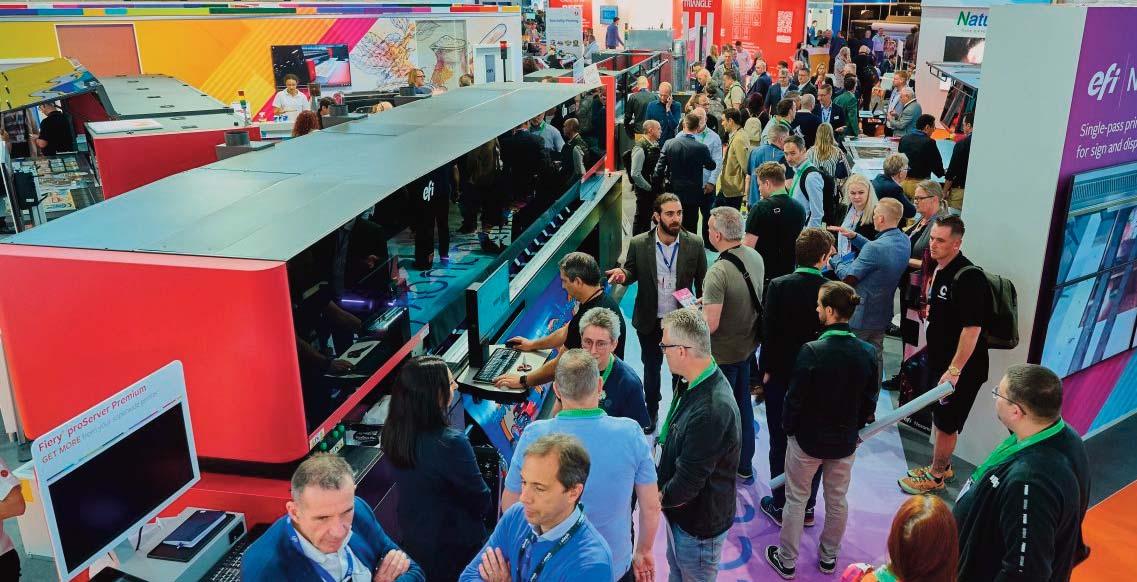
Following a successful launch in Dubai in 2024, FESPA Middle East is gearing up for its second edition from 20-22 January at the Dubai Exhibition Centre. As a global federation of associations for the digital printing, textile and screen-printing community, FESPA is a non-profit organisation that has reinvested US$9 million into the printing industry worldwide since 2015 through its Profit for Purpose programme.
Profit for Purpose is an international reinvestment initiative designed to channel revenue from FESPA events into supporting the sustainable and profitable growth of the global speciality print community. The programme fosters the development of print businesses by providing market insights and facilitating valuable networking opportunities.
Some of the actions it undertakes to deliver this reinvestment initiative, include: the production of technical guides and sustainability guides which offer advice for business owners and are
available to FESPA members; the FESPA Print Census report giving insights on trends and long-term growth; funding for association projects who deliver localised activities; as well as bespoke events to connect key stakeholders such as the FESPA Leadership Exchange (FLEX) which was hosted in Dubai in 2023 and at
FESPA Middle East 2024 to share knowledge and discuss future trends.
"As a not-for-profit organisation, FESPA has a unique focus, driven by a mission to promote growth and knowledge-sharing in the printing sector and provide ongoing support to the industry worldwide. FESPA Middle East is

an important addition to our global portfolio and highlights our commitment to promoting the region’s thriving print sector, making us very different to other trade exhibition organisers," said Bazil Cassim, Regional Manager (Middle East and Africa), FESPA.
With a global network of over 14,000 members worldwide, FESPA has created a range of exclusive benefits to support those within the industry, including preferential access to exhibitions, networking opportunities, and expert industry insights in multiple languages and a host of informational guides and white papers. Industry professionals within the MENA region can sign-up to FESPA Direct membership in order to access the curated materials and forum.
Visitors to FESPA Middle East 2025 will also have access to a wealth of content when the event returns to Dubai in January next year, with a dynamic showcase of live competitions, learning opportunities, and business-building sessions. On the exhibition floor, you will be free to attend FLEx (FESPA Leadership Exchange), a range of conferences featuring international speakers and experts from across the printing industry covering topics such as Business Building, Personalization, New Technology/Future Vision, Brand Perspective, Sustainability in print.
The event will also host the popular World Wrap Masters – Middle East, part of a global competition series in which wrap installers demonstrate their proficiency, expertise, and technique. In addition, FESPA Middle East will feature Wrap Demos in collaboration with official Learning Partner, The Wrap Institute, providing valuable techniques, tips, and guidance on maximising profits for professionals in the vinyl wrapping industry.



The Sustainability Spotlight stand feature is also set to return, allowing attendees to explore a unique showcase

of 100+ sustainable print material samples with data sheets for sourcing, ideas on reducing waste and optimising resource use.
The sectors featured at FESPA Middle East include digital printing, textiles, signage (including digital signage) and screen printing. The inaugural edition featured over 150 brands and exhibitors, and over 3,000 visitors had the opportunity to explore thousands of products on display.
Registration for FESPA Middle East is now open at www.fespamiddleeast.com, and visitors can register for free entry using promo code FMEM501.
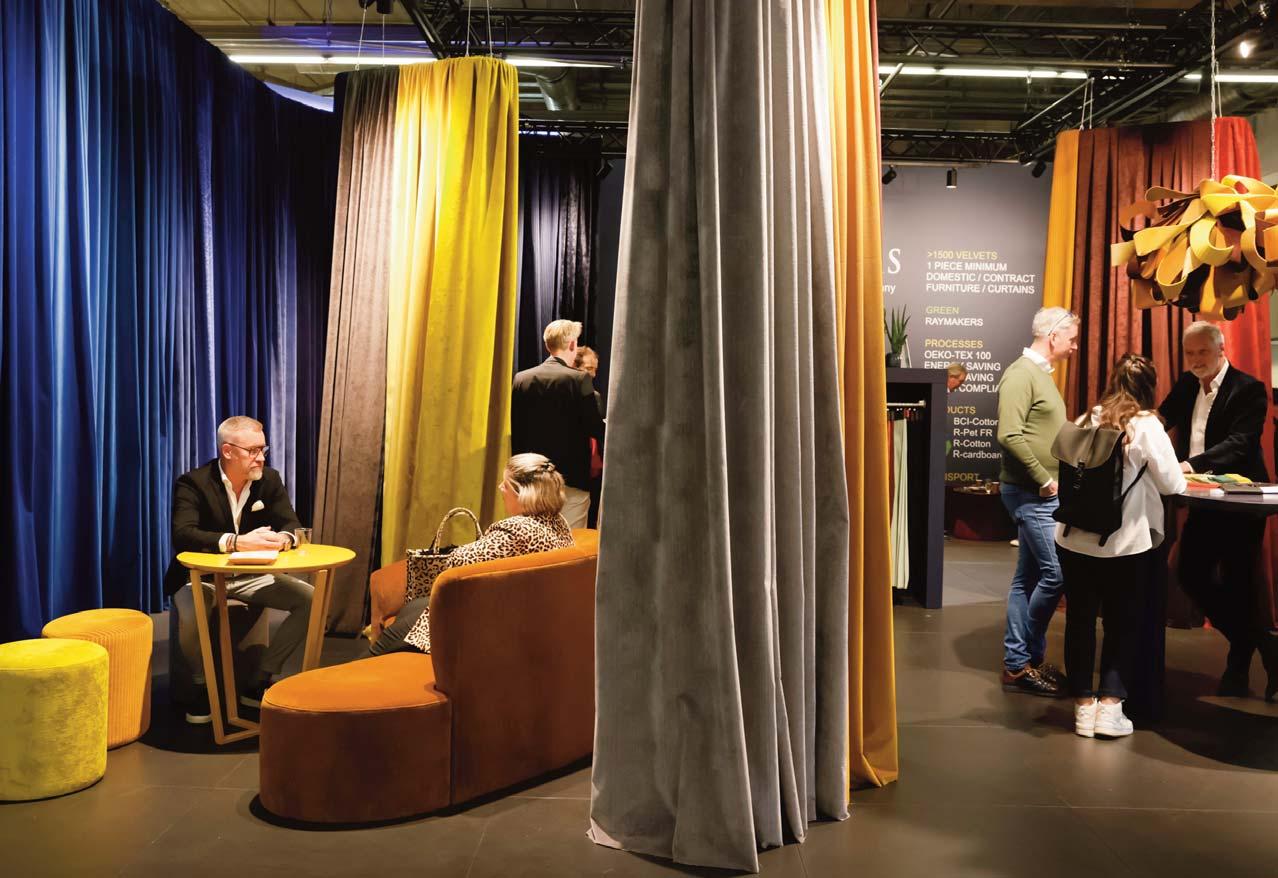
Functional, reliable and innovative – this is how the products for the contract sector are presented at Heimtextil in Frankfurt from 14 to 17 January 2025. Interior designers, architects and hospitality experts awaits a broad and international range of textiles, specifically for use in public buildings and facilities.
From 14 to 17 January 2025, Heimtextil will be the first stop for architects, interior designers and hospitality experts looking for contract textiles. Here, they find the entire spectrum of textile furnishings in one place and at the same time an informative comprehensive programme, design and trend inspiration. Top international exhibitors and innovative newcomers present their latest products for the contract business. The entire textile spectrum is covered – from wallpapers, curtains and sun protection,
upholstery and outdoor fabrics, bedding, bed linen, bathroom textiles, mattresses and sleeping systems, fibres and yarns to carpets.
'Contract textiles are the champions league of home textiles. They are subject to the highest demands in terms of
quality, functionality, safety and design. Year after year, our exhibitors outdo themselves with innovative products and further developments in functionality.
This makes it all the more important to stay up-to-date, discover the most promising innovations and explore the

new possibilities’, explains Bettina Bär, Director Heimtextil.
Whether in offices, hotels, restaurants, hospitals or public transport –textiles are an essential part of furnishings and fulfil important tasks. They provide comfort, influence the room atmosphere and are also real all-rounders. Flameretardant, antimicrobial, water-repellent, dirt-repellent, lightfast, sound-absorbing, cooling and many other functionalities characterise contract textiles. After all, fire protection, hygiene standards and extreme areas of application demand absolute reliability in their properties. Exhibitors with corresponding products can be found quickly in the Interior.Architecture.Hospitality FINDER.
An additional signet makes the relevant exhibition stands noticeable at the trade fair.
Visitors can expect offers from Atenzza Outdoor (Spain), Aydin Tekstil, Barine (Turkey), Bedding House (Netherlands), Cabanes & Ortuno (Spain), Elastron Portugal, Englisch Dekor (Austria), Futura Leathers (Italy), Gebrüder Munzert, Höpke Textiles (Germany), Indetex (Belgium), Indorama Ventures Fibers Germany, Kücüker Tekstil (Turkey), Lameirinho (Portugal), Marburger Tapetenfabrik (Germany), Martinelli Ginetto (Italy), Mundotêxtil (Portugal), OBB Oberbadische Bettfedernfabrik (Germany), Têxteis J.F. Almeida (Portugal), Textil Blanca 1941 (Spain) and The Wallfashion House (Belgium) among others.
'We are looking forward to showcasing our new products and innovative technologies at Heimtextil.
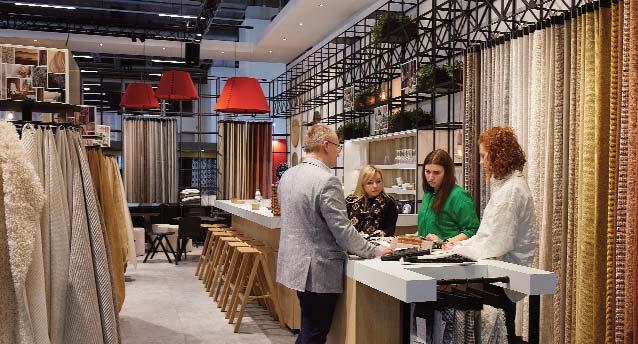

These include a textile fabric with waterbased silicone protection which is resistant to external influences as well as modern and functional curtain solutions which have been developed specifically for the contract sector. Interior designers, architects and hospitality experts also find customised offers for their specific project requirements’, states Sabine Danneberg, Global Contract Sales Director at Höpke Textiles.
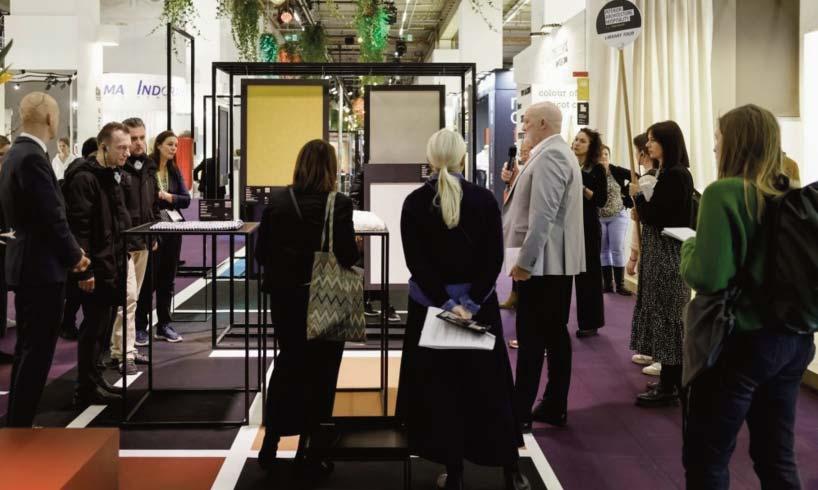
'With a focus on sustainability, skin sensitivity and support for regenerative sleep, our range goes beyond standard bedding. This makes it particularly relevant for the contract sector. The listing in the Interior.Architecture.Hospitality FINDER gives us additional visibility.We look forward to meeting our customers again at Heimtextil 2025 and convincing new interested visitors of our ‘sleep enhancers’, says Petra Schweigert, Managing Partner at OBB Oberbadische Bettfedernfabrik.
Architects, interior designers and hospitality experts can also look forward to a programme tailored to their needs. This includes lectures and guided tours on topics such as AI and sustainability as well as unique special presentations. Absolute must-sees are the Interior. Architecture. Hospitality LIBRARY in Hall 4.0, the Trend Arena in Hall 3.0 and the ‘among-us’ installation by Patricia Urquiola in Hall 12.0.
The U.S. Cotton Trust Protocol, a leading program for responsibly grown cotton, has released its 2023/24 Annual Report, showcasing record grower participation and notable strides in environmental stewardship. The report highlights the program’s progress in driving transparency and continuous improvement across the cotton supply chain, even amidst a challenging economic climate for growers.
“This year’s report demonstrates the unwavering commitment of U.S. cotton growers to continuous improvement, even in the face of significant challenges,” said Dr. Gary Adams, President of the U.S. Cotton Trust Protocol. “The Trust Protocol is proud to support their efforts by providing the tools, resources, and market opportunities needed to build a more resilient and sustainable future for U.S. Cotton.”
Key highlights from the 2023/24 Annual Report include:
Record Grower Enrollment: Planted acreage enrolled in the Trust Protocol grew to 2.1 million acres, a 31% increase from the previous year, demonstrating a strong industry commitment to responsible production.
Tangible Environmental Gains: Trust Protocol growers continued to outperform national averages, achieving a 14% improvement in yield and making significant reductions in water use (14%), energy use (27%), greenhouse gas emissions (21%), and soil loss (79%) compared to a 2015 baseline.
Climate Smart Cotton Program Expansion: The program, designed to help growers adopt climate-smart practices, saw growth with 1,427 U.S. farming entities enrolled, including 282 from historically underserved communities.

Traceability Platform Advancements: The Trust Protocol made noteworthy progress in scaling its Protocol Consumption Management Solution (PCMS), recording 1.2k shipments of cotton fiber (equivalent to 3.4 million bales of U.S. Cotton and 636,000 bales of Protocol Cotton).
Enhanced Governance and Collaboration: The Trust Protocol expanded its Board of Directors to include greater international representation and joined the United Nations Fashion and Lifestyle Network, underscoring its commitment to global collaboration.
“It’s not always easy to take risks when you’re a farmer, especially financial risks,” said Alyssa Cain, a Trust Protocol grower from Texas. “This program gives us the support to try new things, to build a better system for the long haul. That not only provides peace of mind but a farm with healthier soil, cleaner water, a system that works with nature, not against it.”
The 2023/24 Annual Report also details the Trust Protocol’s efforts to enhance its data collection and analysis processes, expand its Climate Smart Cotton Program, and strengthen its traceability platform to meet the evolving needs of brands and retailers.
“This year’s report highlights both the progress our growers have made and the operational improvements within the Trust Protocol,” said Daren Abney, Executive Director of the U.S. Cotton Trust Protocol. “We’ve streamlined systems to make participation easier for all and introduced a new consumptionbased membership model launching in 2025 to support companies of all sizes in responsible sourcing.”
The complete U.S. Cotton Trust Protocol 2023/24 Annual Report is available at https://report.trustuscotton.org/
The U.S. Cotton Trust Protocol is the voluntary sustainability program for U.S. cotton growers and traceability platform for all U.S. Cotton. It brings quantifiable and verifiable goals and measurement to the issue of responsible cotton production and drives continuous improvement in six key sustainability areas: land use, soil health, water management, greenhouse gas emissions, energy use, and fiber quality. The Trust Protocol underpins and verifies U.S. cotton’s sustainability progress through sophisticated data collection and independent third-party verification.


Monforts recently celebrated its 140th anniversary at a special event for staff and their families at its headquarters in Mönchengladbach, Germany. Building on a very rich history since its foundation by August Monforts in 1884, the company remains 100% dedicated to the development of technologies that will ensure the future success of its textile industry customers.
“We have moved over the many decades through mechanical and steampowered technologies to the first mass production lines, electronic drives, special machine construction and highly modular machines,” observes Monforts Managing Director Gunnar Meyer. “Now we are truly in the digital age, and we are committed to investing in the digitalization of our technology, with concepts which assure an overall quality control and energy monitoring.”
The first Monforts machines were mechanical napping units for raising the surfaces of cotton fabrics, providing softness and warmth and adding value. By 1893, Monforts 24-roller napping machines were drawing appreciative crowds at the World Fair in Chicago –establishing international trade networks was paramount to the company from the outset.
In 1897, August Monforts established an iron foundry equipped with hydraulic casting machines, by which time the company employed 1,200 people. This was followed by the introduction of semiautomatic manufacturing tools – an area in which Monforts achieved a number of firsts, such as the single-spindle lathe which became a big export hit in the late 1930s due to its unique and unmatched precision.
Overseen by successive four generations of the Monforts family, the company’s range of textile machines has been significantly expanded based on decades of accumulated know-how and a dominant position in fabric finishing technologies has been established.
Since 2013, Monforts has been a member of the CHTC Fong’s Group, today one of the world’s largest textile machinery manufacturers.
Monforts Montex stenters – for processes such as drying, stretching, heat-setting and coating – are now the industry standard for the fabric finishing industry, not only in the sectors of denim and home textiles, but also in the field of technical textiles, with numerous patents registered over the course of the decades for premium quality and a number of advantages in terms of production
throughput and especially in energy efficiency and savings. The other key technologies in the Monforts range include DynAir relaxation dryers, Thermex continuous dyeing ranges, Monfortex compressive shrinking ranges and Montex®Coat and coaTTex coating units.
Since its opening in 2013, the €2.5 million Monforts Advanced Technology Centre (ATC) in Mönchengladbach has proved an invaluable resource to customers for achieving new standards in fabric finishing.
Over an area of 1,200 square metres, it houses two full finishing lines, engineered to accommodate an extremely diverse range of processes, in addition to a Thermex range for the continuous dyeing of denim and other woven fabrics, a full colour kitchen and a number of lab-scale systems for smaller batch trials.
“The ATC allows our customers to test their own textiles and technical fabrics on Monforts dyeing and finishing machines under fully confidential, real production conditions,” says Monforts Technologist Saskia Kuhlen. “Using the results from these trials, we are also able to make recommendations for improving many fabric finishes.”
For over 40 years, Monforts finishing machines have been manufactured at Montex Maschinenfabrik based in St. Stefan, Austria.
“From the outset, we have specialised in all aspects of machine production, including highprecision sheet metal working, laser cutting and welding, and the preassembly of machines and components, along with a wellorganised quality management and spare parts service,” says Montex plant manager Gert Hanzl. “We work very closely with the Monforts research and development team in Mönchengladbach to take the latest new ideas through testing and prototyping, in readiness for future series production. We are fully exploiting the many new possibilities in the continuous development of design and manufacturing methods.”
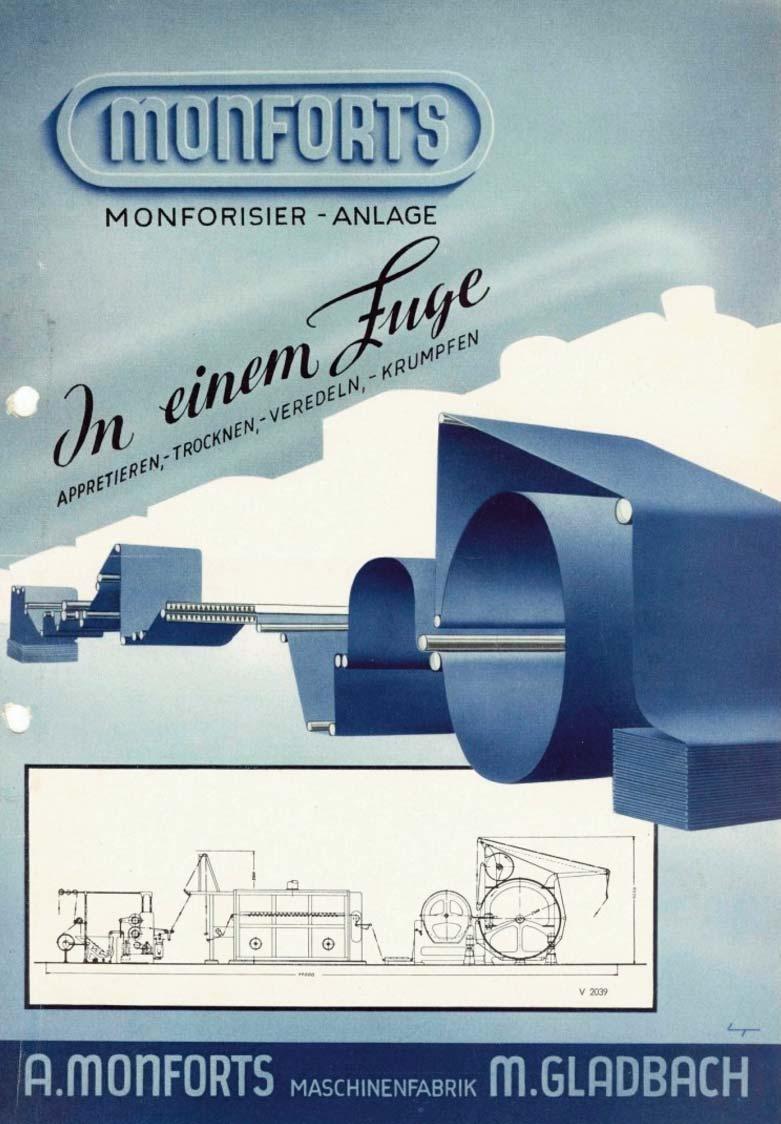
bespoke machines with unique designs, according to the special needs of customers in technical textile or special textiles.
While there is standardisation in series-produced Monforts machines, Montex Maschinenfabrik is also increasingly called upon to construct
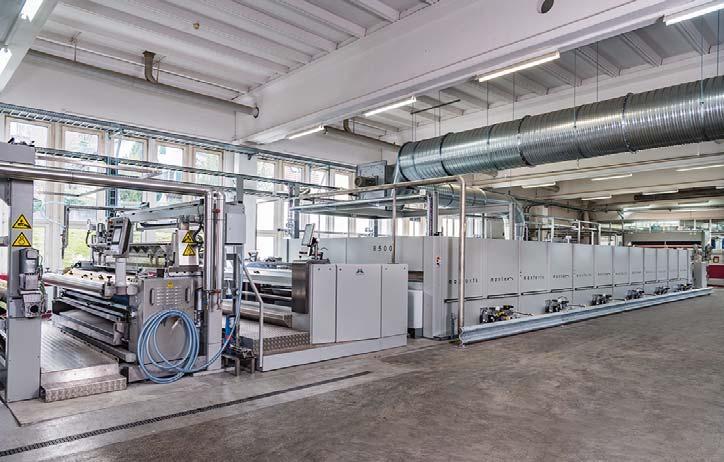
“Our machines are built to last and known for their robustness and long service life,” concludes Gunnar Meyer. “Textile companies making major capital investments in new manufacturing lines rely on durability from our production ranges, and it’s for this reason that there are currently an estimated 2,000 Monforts machines in operation worldwide – some of which were first installed over 30 years ago.
“It would not have been possible for Monforts to have thrived for 140 years without successfully and rapidly responding to industry changes and this continues today. I would like to thank all of our dedicated staff in Germany and Austria and our many colleagues and partners around the world for their continuous contributions to ensuring our further longevity.”

The LYCRA Company, a global leader in developing durable, sustainable and innovative fiber and technology solutions for the apparel and personal care industries, has announced the publication of its third annual Sustainability Update and its abridged Global Sustainability Scorecard for fiscal year 2023. These documents detail the company's progress toward achieving its 2030 sustainability goals.
The LYCRA Company’s sustainability framework, known as Planet Agenda, encompasses every aspect of its business and includes three pillars: product sustainability, manufacturing excellence, and corporate responsibility. The sustainability goals outlined in these documents are structured around these
pillars and are aligned with five of the United Nations Sustainable Development Goals (SDGs).
“Our latest sustainability update demonstrates our long-term commitment towards a more sustainable future,” said Steve Stewart, chief brand and innovation officer of The LYCRA Company. “Delivering on our ambitions to drive meaningful change as we make progress against our 2030 goals inspired this year’s theme, Turning Ambition into Impact.”
Highlights of the 2023 Sustainability Update include advances on the commercialization of bio-derived LYCRA® fiber made with QIRA®, the introduction of industrial compostable LYCRA® fiber for the personal care segment, the
extension of technologies that add durability to the LYCRA® ADAPTIV fiber portfolio, and a 26% reduction in Scope 1 and 2 emissions from the previous year.
This announcement follows the company’s recent Science Based Targets initiative (SBTi) approval of its near-term science-based emissions reduction targets. The LYCRA Company has committed to reduce absolute Scope 1 and 2 GHG emissions by 50 percent by 2030 from a 2021 base year. In addition, the company will reduce absolute Scope 3 GHG emissions by 25 percent within the same timeframe.
To download a copy of the 2023 Sustainability Update or Global Sustainability Scorecard, visit lycra.com/update.

Trützschler Nonwovens and Texnology to supply complete needle-punching line to O.R.V. Manufacturing S.p.A., Italy
Trützschler Nonwovens and Texnology
S.r.l. have received an order from O.R.V. Manufacturing S.p.A. to deliver a new production line for needlepunched and thermobonded polyester media which, among others, will serve the huge market for filter media. The collaboration of the three family-owned companies will establish one of Europe’s biggest multi-purpose lines at the leading producer of non-woven fabrics and polyester wadding in Italy and Europe. The celebration on October 1st marked the start of the project.
For over 75 years, O.R.V. Manufacturing, which is part of the Peruzzo Productions Group, has been producing non-woven products for various applications, including clothing, furnishings, coating supports, filtration, thermal-acoustic insulations, and a variety of different products for the automotive sector. Their production sites in northern Italy are located in
Carmignano di Brenta and Grantorto (PD), while the other non-woven companies of the group are active in southern Italy, Romania, Poland and Brazil. “With Trützschler Nonwovens and Texnology, we are pleased to have found two partners with whom we can realize this major project based on the shared values of a family-owned business,” says Gabriele Zanella, CEO of O.R.V. Manufacturing.
Charlotte Fontaine, member of the Shareholder’s Committee of the Trützschler Group, joined the celebrations at O.R.V. Manufacturing in Italy together with Nicola Olivo, Co-owner of Texnology, and Massimiliano Giacobbo Peruzzo and Cristina Giacobbo Peruzzo, both shareholders of the Peruzzo Productions Group. She says: “This installation does not only represent a significant technological advancement, but also embodies the spirit of innovation and entrepreneurship that characterizes our partnership. By building one of
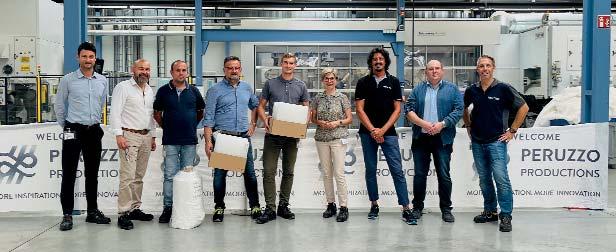
Europe's biggest multi-purpose production lines together with Texnology and O.R.V. Manufacturing, we will set new industry standards.”
The journey began with an unforgettable customer event at the Nonwoven Customer and Technology Center (NCTC), where nonwovens ranging from 35 to 1400 grams per square meter (gsm) were showcased. This event led to collaborative product development days that solidified the shared vision of the three companies.
“T-SUPREMA serves a wide range of applications while achieving top-quality outputs and outstanding efficiency,” says Oliver Döring, Director Sales & Marketing Trützschler Nonwovens.
Trials convinced the customer
Initial customer trials in May at the NCTC in Egelsbach, Germany, convinced O.R.V. Manufacturing of the versatility of the high-performance line. “We build strong, lasting relationships with our customers to ensure consistent quality and performance. We strive to set new industry standards while implementing environmentally conscious solutions. Together, we leverage the unique strengths of each company and transform these values into high-quality products,” says Nicola Olivo, Co-owner of Texnology.

Benninger, a global leader in the development and production of textile finishing systems, designed a jigger for exceptional performance in the field of discontinuous fabric dyeing, ideal for delicate and intricate fabrics.
Benninger JigMaster integrates innovative features that allow dyers to improve their processes while reducing the environmental impact. Customers are excited; the case of Swisstulle is exemplary.
JigMaster shows cutting-edge technology meeting the demands of modern textile manufacturing. The system, developed in Switzerland and produced in Benninger's state-of-the-art facility in Pune, India, represents a significant advancement in fabric dyeing machinery – just perfect for companies like Swisstulle requiring machinery for highest standards of precision, quality, and sustainability.
A perfect fit to Swisstulle's high standards
Swisstulle (www.swisstulle.ch), a leader in the European market for traditional bobbinet tulle and technical
Benninger’s high-tech jigger is the perfect choice for demanding dyers TwinJig
knitted fabrics, decided for JigMaster to improve its textile dyeing and finishing processes. This strategic choice aimed for further enhancement of the company's production capabilities, particularly in washing and dyeing of high-quality technical textiles. Counting over a hundred years of experience, Swisstulle continues to pioneer innovation, ensuring the highest quality and sustainability in its offerings.
Swisstulle supplies its renowned bobbinet tulle and technical textiles to
industry segments ranging from fashion to automotive. JigMaster plays a crucial role in supporting their production goals in the area of technical textiles used for sun protection and other high-demand applications.
“Benninger JigMaster provides Swisstulle with a new level of efficiency and sustainability, perfectly aligned with our commitment to resource-conscious production,” says Achim Brugger, CEO at Swisstulle. By integrating the JigMaster into its production line, Swisstulle ensures

that its fabrics not only meet but exceed customer expectations, while also advancing its environmental responsibility. The machine’s plug & play capability allows for quick setup and seamless integration into existing production workflows, minimizing downtime and maximizing productivity.
One of the standout features of Benninger JigMaster is its TwinJig technology, which includes two independent troughs, enabling Swisstulle to save up to 35% water during rinsing. This technology also optimizes energy usage, making the dyeing process more eco-friendly without compromising on fabric quality. The machine’s counterflow rinsing and high mechanical washing effect further enhance resource savings by reducing water and steam consumption. These are significant advantages given the textile industry's growing focus on sustainability.
Moreover, JigMaster offers fast heating gradients, enabled by two highcapacity heat exchangers, speeding up production while maintaining superior fabric care. Its BEN-CONTROL software guarantees precise speed and tension control, essential for Swisstulle’s fine fabrics, which require low-tension dyeing to avoid creases or edge marks. Additionally, the machine features precise length measuring and sampling point
detection, ensuring consistent quality throughout the production process.
A future-proof partnership
The partnership between Swisstulle and Benninger is a testament to both companies' shared commitment to innovation and sustainability. “With the installation of JigMaster, we strengthen our position as a forwardthinking textile manufacturer. We use the most sophisticated tools to produce highperformance fabrics efficiently and ecologically,” says Brugger.
Benninger is a Swiss company and has been the world's leading partner of the textile and tire cord industry for more than 160 years. It has subsidiaries as well as service agencies around the globe. Benninger develops and produces machines and systems for textile finishing and tire cord

production, which it supplies as complete system solutions. Benninger has many years of experience in the automation of machines and systems which is also used successfully in other branches of industry.


The innovative Italian textile company Beste Spa has placed an order for a complete Rieter ring spinning system. The latest Rieter technology, in conjunction with digitization and automation solutions, will support Beste in setting up the entire textile production process locally in Italy, centered around producing the highest quality for luxury brands. This investment is a key component of the ITACO project, which focuses on creating a 100% organic and fully traceable Italian cotton supply chain.
Beste and Rieter have signed an order to exclusively equip the newly founded spinning mill, FILUM S.R.L., in Bergamo, Italy, with the latest Rieter technology, including a complete ring spinning system. This is a pivotal step in the ITACO project, which encompasses every phase of cotton production – from the cultivation of organic cotton in southern Italy to spinning in Bergamo and garment manufacturing in the Prato region. Everything is done within a few hundred kilometers, providing unparalleled control over quality and sustainability, making Beste’s supply chain fully transparent.
From fiber preparation to winding, the new spinning mill will be exclusively equipped with the latest Rieter technology. With the fully electronic ring
spinning machine G 38, equipped with the compacting device COMPACTapron, Beste produces combed compacted yarn that meets the highest standards required for its ITACO collection.
The all-in-one digital mill management system ESSENTIAL connects data throughout Beste’s new spinning mill, giving the company a comprehensive view of all relevant performance indicators from bale to package. The fully automated piecing robot ROBOspin ensures consistent performance of the ring spinning machines and minimizes personnel deployment. The fully automated roving bobbin transport system SERVOtrail Direct further reduces personnel requirements as no manual bobbin transport is needed.
Giovanni Santi, CEO of Beste, states: “We engage with partners who share our philosophy and standards. Rieter machines meet our demand for the highest quality and enable us to produce yarns for our garments that embody the design and quality hallmarks of ITACO, our unique, fully traceable Italian cotton project.”
Roger Albrecht, Head of the Rieter Business Group Machines & Systems, adds: “We are proud that Beste has chosen our technology to accelerate their growth momentum. Our ring spinning system perfectly fits into this complete Italian production chain, supporting the ITACO project’s vision of high-quality, sustainable garments.”


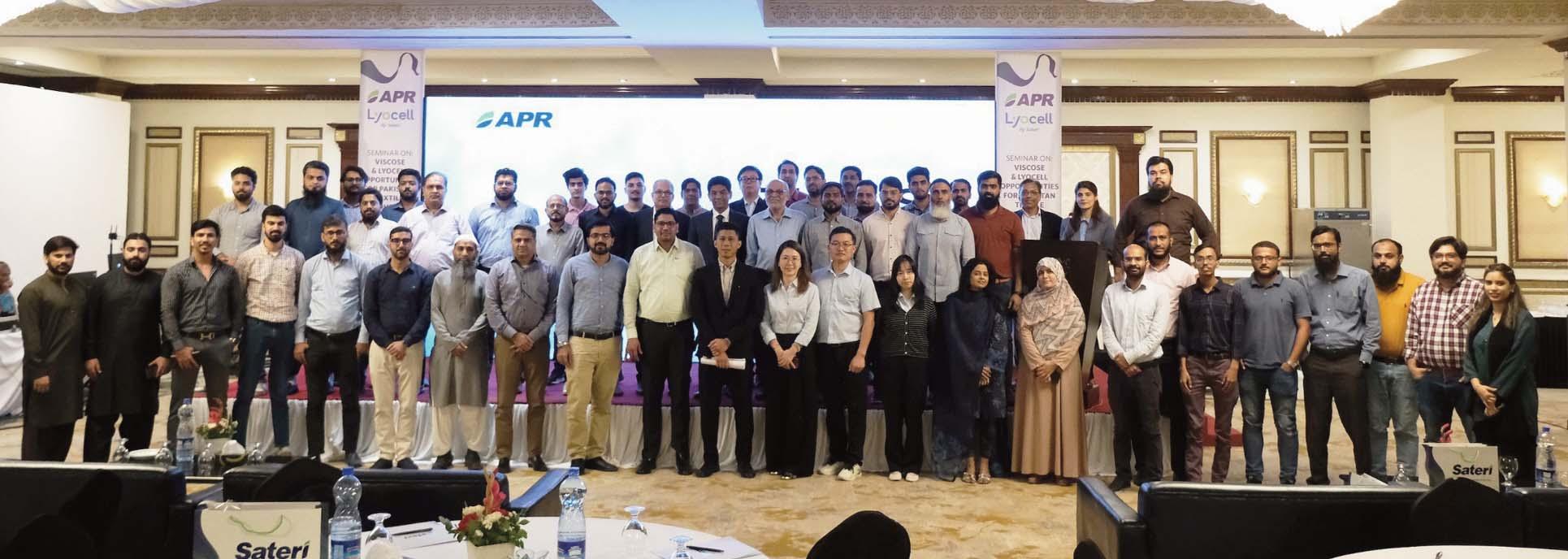
Asia Pacific Rayon (APR), the first fully integrated viscose rayon producer in Asia, marked a significant milestone with its inaugural customer meet in Pakistan. Held at Karachi’s Pearl Continental Hotel, the event on September 25, 2024, brought together approximately 120 representatives from Pakistan’s textile sector. Themed “Viscose & Lyocell Opportunities for Pakistan’s Textile Industry,” the gathering served as a platform to explore sustainable innovations, discuss industry trends, and forge potential partnerships.
APR, headquartered in Indonesia’s Riau province, has steadily expanded its footprint in Pakistan over the past five years. Recognizing the strategic importance of Pakistan’s textile industry—which employs 40% of the nation’s workforce—APR sees immense potential in fostering sustainable textile production in the region.
“We aim to position Pakistan as a global hub for sustainable textiles,” said Nauman Ilyas, APR’s Sales and Business Development Manager for Pakistan. “The unique sustainability attributes of our viscose rayon resonate with the growing demand for environmentally responsible fabrics. We look forward to expanding our collaborations here.”
The event underscored APR’s vision of fostering collaborations between local and international stakeholders to propel sustainable textile production in Pakistan. By encouraging the adoption of Lyocell and viscose rayon, APR aims to strengthen Pakistan’s position as a leader in the global textile market while supporting its sustainable economic growth.
A key focus of the event was Lyocell, a biodegradable fibre derived from sustainably sourced wood pulp. With exceptional environmental and performance characteristics, Lyocell is increasingly viewed as a cornerstone for sustainable fabric production.
Sateri, APR’s sister company and a leader in cellulosic fibre production, has already captured 30% of Pakistan’s growing Lyocell market, which has expanded rapidly—from 14,000 tons in 2019 to over 45,000 tons in 2024, according to Shoaib Dewan, Director at TexTrading.
Dewan highlighted the critical role of Lyocell in the face of declining global cotton production: “The global textile industry is turning to sustainable manmade fibres, and Pakistan is no exception. The soaring demand for Lyocell is a testament to this shift.”
Sateri’s Downstream Business Development Manager, Louis Tsai Tsung
Ying, reinforced this sentiment. “The global Lyocell capacity is projected to rise from 900,000 tons to 3.2 million tons by 2030. We are committed to sustainable practices and innovation, ensuring we meet the growing demand while expanding our footprint in Pakistan.”
Both APR and Sateri emphasized their adherence to stringent sustainability standards. APR’s production facilities comply with the EU BAT Polymer BREF guidelines and the Zero Discharge of Hazardous Chemicals (ZDHC) framework. The company’s viscose staple fibres boast certifications such as OEKOTEX® Standard 100 and FKT OK biodegradability labels, making them a preferred choice for eco-conscious markets.
Ismail Usuluddin, Digital Marketing Manager, APR shared, “Our Lyocell is made from 100% bio-based products certified from United States Department of Agriculture (USDA) and The United States Food and Drug Administration (FDA) with no petroleum-derived ingredients.”
Sateri’s cellulosic fibre factories are certified by the Programme for the Endorsement of Forest Certification (PEFC) and meet European Union Best Available Techniques (EU-BAT) standards, further underscoring their commitment to responsible production.








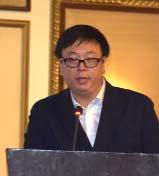


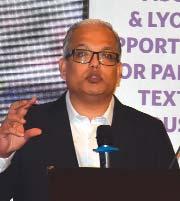


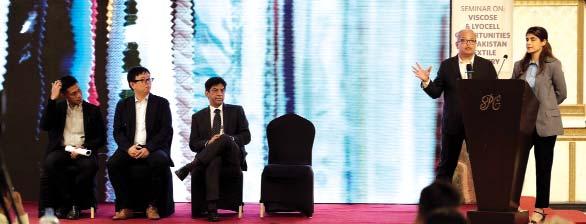
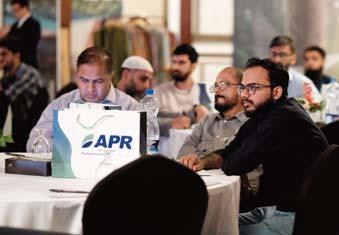




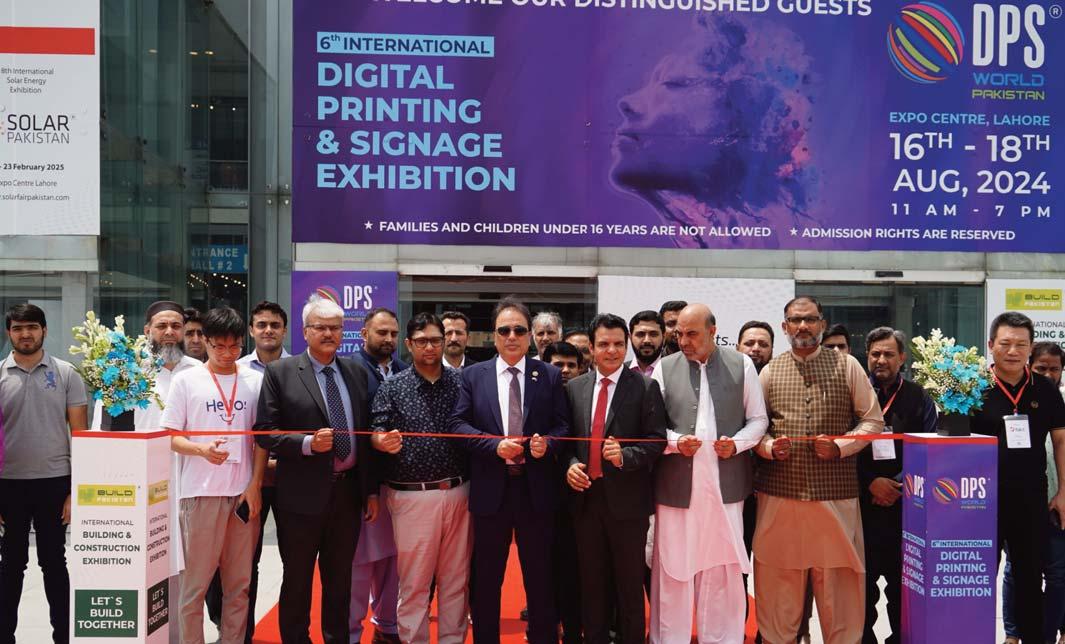
6th DPS WORLD PAKISTAN, organized by Fakt Exhibitions, successfully concluded on a high note. This premier event for digital printing and signage technology took place at the Expo Centre, Lahore from 1618 August, 2024.
The exhibition brought together over 100 national and international companies, showcasing the latest advancements in digital printing technology and signage solutions. It provided a unique platform for businesses to present their cuttingedge innovations, from high-tech digital printers to advanced signage systems, all under one roof.
WORLD
served as a dynamic hub for networking, learning, and collaboration. With prominent industry leaders and emerging talents, participants had the opportunity to engage with experts, gain insights into the latest trends, and explore new business opportunities, making the event a resounding success.



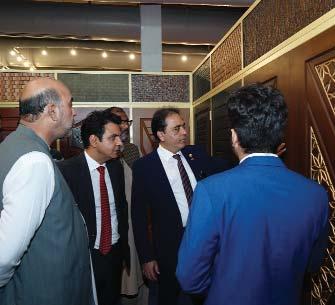




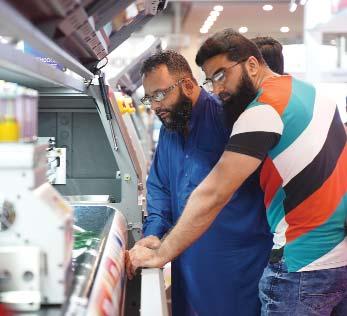










ITMA ASIA + CITME, the region’s leading textile machinery exhibition, ended successfully after a five-day showcase on 18th October 2024. It attracted visitorship of about 90,000, with strong local attendance. The visitors came from 111 countries and regions.
Eighty-seven per cent of the visitors were from China. Local visitors came from 31 provinces and cities. Jiangsu, Zhejiang, Shanghai, Guangdong, Shandong, Fujian, Hebei, Henan, Anhui and Hubei ranked in the top ten, demonstrating the strong vitality of the textile industry in these regions and the interest in new textile machinery trends.
Similar to the 2022 edition, India topped the list of overseas visitors. It is followed by South Korea, Bangladesh, Indonesia and Iran.
Many of the exhibitors were satisfied with the results achieved from their participation, according to the show owners, CEMATEX, the Sub-Council of Textile Industry, CCPIT (CCPIT TEX), China Textile Machinery Association (CTMA)
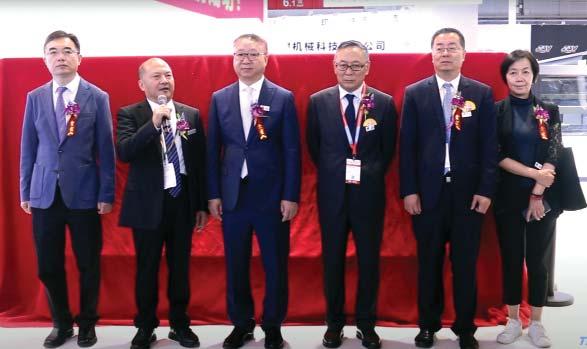
and China International Exhibition Centre Group Corporation (CIEC).
Federico Businaro from Sperotto Rimar remarked, “As always, ITMA ASIA + CITME confirms itself as a decisive textile machinery exhibition for the huge Chinese market. We met many contacts and good sales prospects.”
Rick Stanford, VP Global Business Development at Baldwin Technology Company, agreed, “We found our partici-
pation to be a most worthwhile experience and it yielded better than expected results. The quality of local visitors at our booth is excellent.”
Several Chinese exhibitors were also satisfied with their participation. From among them, Tan Jingdan, General Manager, Changshu Guosheng Knitting Machinery Factory, said: “Many customers came with the intention to source fully computerised machines. On the first day of the exhibition, we received several


orders. This proves that the company’s strategy of moving towards high-end, intelligent solutions is the right path for the company to take.”
Summing up the sentiments of many exhibitors, Stephan Kehry, International Sales Manager Textile Division, Erhardt+Leimer, remarked: “ITMA ASIA + CITME has once again impressively demonstrated that quality and innovation are still the main factors for not only surviving against an ever-increasing competition, but also for emerging from it stronger.”
Held at the National Exhibition and Convention Centre (NECC) Shanghai, ITMA ASIA + CITME 2024 grossed 160,000 square metres, occupying six halls of the venue. It attracted over 1,700 leading textile machinery manufacturers from 22 countries and regions.
Next year, ITMA ASIA + CITME, Singapore 2025 will be held at the

Singapore Expo from 28 to 31 October 2025 (www.itmaasiasingapore.com).
It will be followed by ITMA ASIA + CITME 2026 which will be held from 20 -
24 November 2026 at the NECC in Shanghai. For more information, please visit www.itmaasia.com or www.citme.com.cn.


With 42 exhibiting member companies, ITMA ASIA + CITME 2024 is once again marked by a strong presence of VDMA companies. They cover nearly all different machinery chapters with a focus on spinning and man-made fibers, nonwovens, weaving, braiding, knitting & warp knitting, finishing & dyeing as well as technologies for textile recycling and processing of recycled material.
In total, the German participation at the fair is the largest from outside China.
China is aiming at a green and low CO2 development of its textile industry. At a press conference on the first day of ITMA ASIA + CITME, Georg Stausberg, member of the board of VDMA Textile Machinery and CEO of the Oerlikon Polymer Processing Solutions Division said: “Topics, such as energy efficiency and the careful use of resources have become increasingly important for Asian customers in recent years, not least due to stricter legal framework conditions. VDMA members and their technologies are the right partners on the road to a greener and low CO2 textile production.”
Already in 2023, the global textile machinery exports decreased by 18.6 per-
cent compared to 2022. This was a challenge all major textile machinery producing countries had to face. However, the German exports remained relatively strong and only declined by 3.4 percent in 2023. 2024 did not see a change in the global textile industry and thus the German exports have now also dropped significantly. Between January and July 2024, German exports of textile machinery and accessories summed up to 1.2 billion euros (2023: 1.6 billion euros). The shipping to almost all major markets decreased between January and July: China: 242 million euros (2023: 384 million euros), Turkey: 140 million euros (2023: 180 million euros), USA: 118 million euros (2023: 152 million euros), India: 100 million euros (2023: 153 million euros).
An economic survey of VDMA in September, to which 20 textile machinery companies replied, reflects the global challenging situation. Around 36 percent assessed their current business situation as satisfactory, 54 percent said it was bad. Only very few companies expect the global situation to improve in the next six months
However, looking at the sales opportunities by regions/countries in Asia, most of the responding companies expect a better business situation in the Asian markets except China in six months. The business situation is expected to be on a
satisfactory level then. With regard to this, a presence at ITMA ASIA in Shanghai and next year in Singapore is important for VDMA members to continuously show their innovations and to keep contact with the customers in Asia.
The contribution of leading VDMA members and their technologies to a green textile production:
The presence of VDMA at this year’s ITMA ASIA + CITME is themed Smart technologies for green textile production.
Here are examples of exhibitors that stand for the entire industry:
Georg Stausberg, CEO of Oerlikon Polymer Processing Solutions Division stated:
“China continues to have enormous potential for us, even if it has not been able to match the previous times in terms


of large new installations of manmade fiber plants and the associated expansion of production capacity for good two years. However, there is still a great need for renewal, especially in terms of sustainability. Shutting down old plants and replacing them with new and energy-efficient technologies is the path to a better and lower-emission future for us all. We have been contributing to sustainability with our technology solutions for decades. Be it by increasing energy efficiency with each new generation of machines or by processing new materials.
Oerlikon is proud of the fact that we have been offering innovative solutions under the e-save sustainability label for 20 years and has saved over 15 million tons of CO2 thanks to the machines and systems developed and installed on the market during this time.”
Hailin Xu, CEO Saurer Group said:
“Processing recycled and regenerated fibres is becoming increasingly important worldwide. Saurer is a key enabler of the transformation towards a more circular textile business. The product portfolio today includes energy efficient machinery for spinning and twisting yarns from recycled fibres. To enable customers to process extremely short fibres, we continue to develop special solutions, which are also available as retrofits for older machines. In addition, our machines have been developed to reduce energy consumption and maximise raw material utilisation. It’s all about saving resources”.
Dr. Axel Hannemann, head of business unit fiber and pellets, Gneuss


Kunststofftechnik explained:
“As sustainability becomes more important, fibre producers are shifting towards recycled PET materials, including post-consumer PET bottle flakes and manufacturing waste. However, the increasing demand for PET bottle flakes has led to a scarcity of affordable, highquality flakes. One challenge in recycling polyester is moisture absorption, which can weaken the polymer during extrusion. Recycling PET fibres, particularly industrial waste, is also difficult due to low bulk density, residual moisture, and spin finish oils. Gneuss offers tailored solutions to address these challenges efficiently.”
On behalf of Karl Mayer Group, Christine Wolters, vice president corporate communications said:
“At ITMA ASIA, we are showcasing solutions that support both sustainability and the profitability of our customers. A key focus is on energy consumption: In the warp knitting sector, we present an energy efficiency solution that reduces

the power usage of our machines. In warp preparation, we have optimized drying processes for more efficient energy use. Energy, cost, and CO2 savings can be monitored live. Another highlight: Our digital products improve processes with positive impacts on both sustainability and costs”.
“Groz-Beckert’s innovative textile tools enhance energy efficiency in textile manufacturing, driving down production costs. A key development is the introduction of a ‘pay-per-use’ pricing model for tools, which allows companies to align expenses with actual tool usage. This enables manufacturers to better handle demand fluctuations, reduce investment risks, and improve resource management. By focusing not only on product innovation but also on service offerings, GrozBeckert is advancing both efficiency and sustainability in textile production” stated Eric Schöller, member of the executive board, Groz-Beckert.
Dennis Behnken, managing director of the company Herzog, the most innovative developer and manufacturer of braiding and winding machinery noted:
“At Herzog GmbH, we rely on smart technologies to make textile production more sustainable. By using digital solutions, intelligent automation and high production quality, we reduce resource consumption and minimize waste. In this way, we make our contribution to a greener future without compromising on the quality of our products.“
“Customer requirements are rising and skilled staff is becoming scarce. Technologies like sensors and control systems are increasingly important for efficient operation and quality assurance”, Kathrin Pleva, member of management of Pleva GmbH said and continued: “Our process control system PLEVATEC smart is


designed to meet exactly those needs. It improves operation at stenters and other drying processes with sensor modules. It enables our customers easy operation to produce faster, save resources and improve product quality and reproducibility. Similarly, our weft-straightener SL smart is easy to operate and maintain while delivering perfect straightening results.”
Tallen Yang, Sales Director Erhardt + Leimer China stated:
“Currently, many textile companies are facing challenging times. The lack of turnover, however, is giving room for improvements. How much money can be saved by a proper fabric guiding, that avoids stoppages due to insufficient pinning? Similarly, how many tons of fabric can be saved by an intelligent, AI-based edge cutting? How much energy can be saved by an optimized stenter management? The time for all these questions is now. And the place for answers is the booth of E+L, leading in process optimization for more than 100 years.”
According to Clemens Kaplan, product manager at Mahlo, a German manufacturer of measuring, control and automation systems for the textile and finishing industry, today’s increasing quality standards require intelligent, AI-supported process and quality management systems. Kaplan said: “As always, Mahlo is ahead of the curve and has reinvented the concept of weft straightening for the second time. The latest straightening technology, Orthopac RXVMC-20, with an AI-supported feed-forward algorithm,
paired with a modular process control system, Optipac, revolutionizes straightening from the ground up. Residual distortions and fluctuations in key parameters such as residual moisture, exhaust air humidity, thread density, fabric weight, fixation dwell time, fabric width, liquor pick-up, etc., are now definitively a thing of the past thanks to this new technology.”
For the company SETEX, provider of MES production management software and control systems for textile machines, CEO Oliver Schermuly stated:
“Manufacturers need a single source of truth for production data. By integrating all KPIs — from costs to carbon footprint — we provide clarity and enable optimization of production processes. Our SETEX controllers ensure seamless machine communication, capturing robust real-time KPIs. This interaction allows fine-tuning, maximizing machine potential beyond standard MES functions into advanced manufacturing excellence. AI-powered smart recipes reduce waste and boost efficiency. Unified data enhances productivity, supports digital product passports, and drives digitalisation for smarter, more sustainable production. Together, we’re creating a single source of truth to build a better, greener world.”
Tobias Schurr, member of the management board of Weitmann & Konrad explained:
“Textile producers getting more and more pressure from brands and retailers to optimize CO2 footprint and water consumption on their products without
increasing their price level. From technology standpoint it could be mostly achieved only by integrating cost intensive, completely new machines with new, sometimes unknown technology. The total investment and running costs have to lead to a price increase which is not accepted in the actual market conditions. What if there is a possibility to upgrade your existing continuous dyeing or finishing line to reduce strongly your CO2 footprint, your water consumption and raise your productivity with a much smaller invest?“
The VDMA team in Shanghai is staffed again with colleagues from the VDMA headquarters in Germany as well as from VDMA China. With these joined forces, the team is well prepared to support the exhibiting member companies on site.
Dr. Harald Weber, Managing Director VDMA Textile Machinery Association, summarised: “Although facing a difficult market situation, this year’s ITMA ASIA is an essential showcase for the member companies of the VDMA Textile Machinery Association. There is definitely no shortage of chances and opportunities in China and other Asian markets. The exhibiting members will demonstrate their smart technologies that can pave the way to a green textile production and are looking forward to welcoming numerous visitors from various countries to their booths in Shanghai.”

With 52 Italian companies at ITMA ASIA + CITME 2024, ACIMIT exhibited from October 14th to 18th in Shanghai. With an area of around 1,400 square meters, Italy ranks among the top exhibiting countries, as in previous editions.
29 Italian exhibitors showcased their innovations within the National Sector Groups, organized by ACIMIT (Association of Italian Textile Machinery Manufacturers) and the Italian Trade Agency.
ITMA ASIA + CITME show has always been the main showcase for textile machinery manufacturers in Asia and absorbs over 50% of global exports. Moreover, China is the world's largest market in the sector (the value of imported textile machinery in 2023 was around 2.6 billion euros).
For Italian manufacturers as well the Chinese market is the foreign destination. In 2023, Italian sales to China amounted to 222 million euros. In the first six months year, exports to China increased by 38%, while the performance of total Italian exports declined slightly in the same period.
ACIMIT President Marco Salvade said, “We hope that the recovery of the Chinese market observed in this first half of the year, may be an early indication of a more general upturn in global demand for machinery.”
Over the past few years, demand from Chinese companies has turned to technologies that combine savings production costs and environmental friendliness, as also demanded by brands and end consumers.

"Today Italian manufacturers can offer highly customized solutions that are particularly suited to making textile production more sustainable confirms Salvade.
The Chinese textile machinery market is rapidly evolving, and the level of innovation in the technology requested has risen due to the growing international competition that even Chinese companies face. In Shanghai, Italian manufacturers displayed their latest innovations, essential for making textile production more efficient and sustainable.”
Meanwhile, Augusto Di Giacinto, Director of ITA Shanghai, states that ITMA ASIA + CITME is the leading textile machinery exhibition in China. As a government agency, the Italian Trade Agency always in partnership with ACIMIT has supported Italian companies to participate in the exhibition for many consecutive sessions. The Italian textile machinery industry will showcase the most advanced Italian manufacturing technologies, with a focus on digitalization and sustainability. Data shows that in the first half of this year. Italian textile machinery exports to China showed a significant growth momentum, which is a positive signal. I
believe that the Italian-Chinese textile machinery trade will continue to maintain a good development momentum next year.
ACIMIT (Association of Italian Textile Machinery Manufacturers) represents an industrial sector that comprises roughly 300 manufacturers (employing ground 13,000 people), which produce machinery for a turnover worth of around 2.3 billion euro, of which 86% are exported. Creativity, sustainable technology reliability, and quality are the hallmarks that have made Italian textile machinery worldwide leaders.
ITA - Italian Trade Agency is the Governmental agency that supports the business development of our companies abroad and promotes the attraction of foreign investment in Italy. With a motivated and modern organization and a widespread network of overseas offices, ITA provides information, assistance, consulting, promotion, and training to Italian small and medium-sized businesses. Using the most modern multi-channel promotion and communication tools, it acts to assert the excellence of Made in Italy in the world.
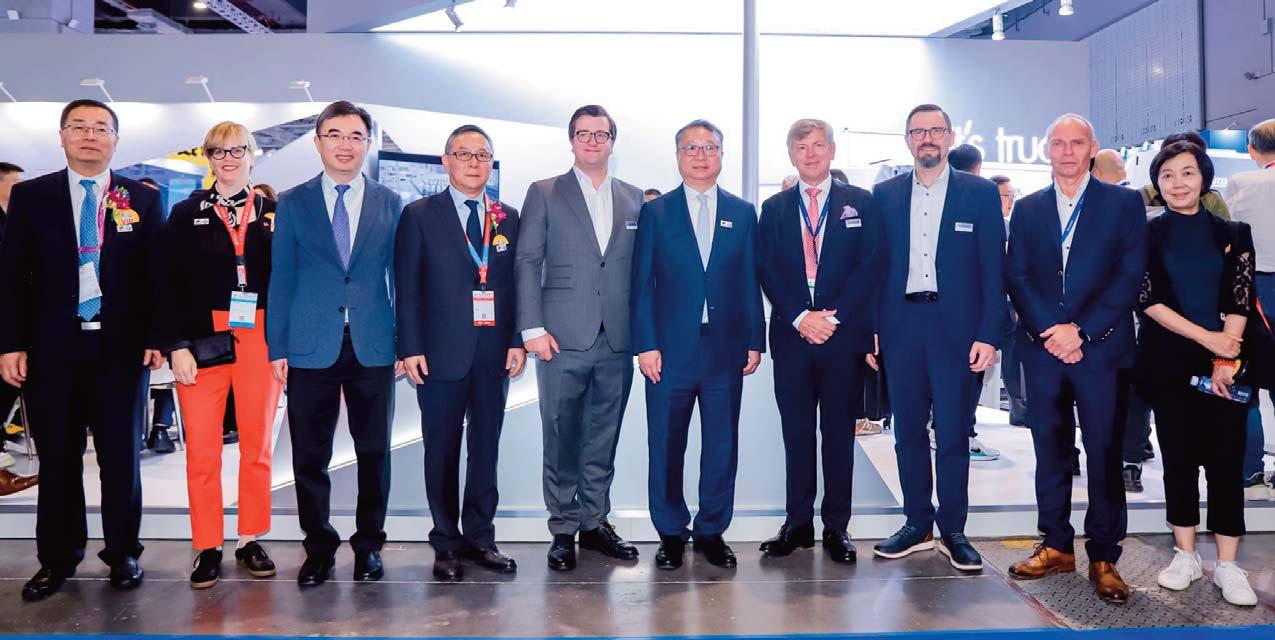
A major milestone was celebrated at the booth alongside the esteemed partner, Murata Machinery, Ltd. Textile Machinery Division, with the achievement of 100 joint customers in China.
The innovative IDF VORTEX Spinning process, which combines Trützschler’s Integrated Draw Frame (IDF) with Murata’s VORTEX machine, was developed. This solution streamlines production, enhances efficiency, and delivers high-quality results for the world’s largest VORTEX spinning market.
Harald Schoepp, General Manager of Trützschler Textile Machinery Shanghai and Jiaxing, said: “Celebrating this milestone with 100 joint customers in China is

(General Manager
Textile Machinery Shanghai and Jiaxing), Florian Schürenkrämer (Member of the Shareholders’ Committee of the Trützschler Group), Daisuke Murata (President and CEO Murata Machinery) and Dr. Michael Schürenkrämer (Shareholder and Member of the Supervisory Board).

a demonstration of the strength of our partnership with Murata. Together, we’ve developed an innovative solution that ensures high-quality output and operational efficiency for our customers.”
Trützschler thanks all the customers and to Murata for their trust and this strong partnership.

Savio participated at the ITMA ASIA 2024 exhibition, which took place in Shanghai from 14th-18th October 2024.
Industry leaders and key players got the opportunity to get together in Shanghai, the earth of Chinese business hub, to explore new business opportunities, forge worldwide connections, and showcase the latest products, services, and technologies in the textile industry.
Savio showcased its latest product range solutions during the exhibition which testified Savio’s dedication to innovation in technology and strong partnerships across the industry. Savio welcomed everyone at their booth in Hall 8 to know more about Savio’s winding, twisting and air jet spinning innovations.
New winding machine: PROXIMA Smartconer®
The newest winding machine from Savio, Proxima Smartconer® has set a new benchmark in Savio automatic winding.
Savio have combined the name Proxima with Smartconer® and now it stands for a high-tech winding machine, capable of perfectly adapting to demands of Connectivity, Industry 4.0 and
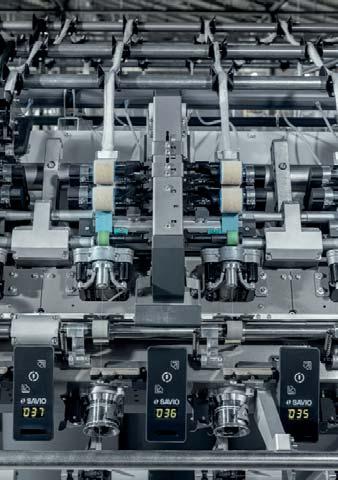
Industrial Internet of Things.

Thanks to this latest innovations, spinners will now have access to a machine featuring high-tech capabilities, thanks to a design with a strong focus on the main benefits for customer’s competitive advantage: high productivity, low energy consumption, premium yarn quality, automation, and data connectivity.
Proxima Smartconer® has been designed with the foremost attention to the customer’s needs in the optimal utilization of a winding machine.Investing in equipment that enables to work faster and reduces manual and repetitive tasks, can increase both efficiencies and overall productivity. The same applies to a new equipment that does more of what is needed, faster, safer, with better quality but with less waste, less maintenance, and less resource usage.

The latest versatile and smart air-jet spinning machine from Savio, Lybra Smartspinner® has been developed with an original spinning technology to serve the customers in specific applications of textile production: knitting, home textiles, sunshades. Air-jet spun yarn has a soft and smooth character, perfectly adapting to creating functional & fashionable fabrics.
With LYBRA Smartspinner®, Savio is offering customers a versatile, flexible, cost saving and easy-to-use machine.
The latest air-jet spinning machine from Savio offers yarn manufacturers the opportunity to produce yarn at high production rates and low processing costs. The air-jet spinning technology uses the same preparation of the conventional ring spinning. This processing works directly with slivers instead of roving, integrating three textile processes: roving, spinning & winding.
Space needs for air-jet spinning is 2530% less than for ring-spinning equipment producing the same capacity, thereby reducing building costs. Also, a smaller area requires less climate control and reduced operating personnel. This results in further substantial savings, maximizing the return on investment.

At ITMA Asia 2024, Saurer’s new products were very popular and in the focus of visitor interest. Investment in new equipment seems to be on the rise and Saurer was positively surprised by the number and quality of visitors as well as the deals closed during the exhibition. Overall, visitors showed great interest in all the Saurer innovations designed to contribute to the future of textile technology and yarn production.
The Autocard SC 8, exhibited for the first time, impressed the visitors with its innovative features and carding area of 4.8m2. The latest generation of air spinning technology, the Autoairo, and the Autocoro 11 – the fully automated rotor spinning machine, were always surrounded by interested visitors. The energy-saving and robust Zinser 51 ring spinning machine produced Siro Compact yarn on the booth, while the PrimeTwister impressed many textile professionals with its flexibility and performance.
Autocard SC 8 – digitalised and monitored high-performance card
With a modern design and the industry’s largest carding section of 4.8 m2, the SC 8 delivers superior fibre utilisation and improved carding uniformity. The machine is equipped with automated settings and smart monitoring, including temperature monitoring for the carding gap, ensuring constant sliver quality. The SC 8 is particularly efficient when processing recycled fibres, providing higher material utilisation rates and improved production efficiency.
Zinser 51 – robust, flexible and energy saving ring spinning machine
The Zinser 51 ring spinning machine demonstrated Siro Compact yarn production and highest speeds during ITMA Asia and attracted a lot of visitors. With a robust design and energy saving features, the Zinser 51 offers easy operation and consis-

tent yarn quality, even with 2056 spindles. Its energy-efficient suction system and flexible automation solutions make it an ideal choice for mills producing high-quality ring or compact yarns or processing recycled fibres.
Known for outstanding high speeds and automation with individual drives, the Autoairo air spinning machine processes cotton and other fibres to yarns with low hairiness and textiles with low pilling. With its speed, compact design and low space consumption Autoairo offers an economical alternative to traditional spinning methods. At ITMA Asia, the Autoairo was spinning up to 500 m/min, showcasing its ability to produce high-quality yarns, named Belairo, ideal for knitted fabrics and towels. The flexibility in use was demonstrated by spinning combed cotton, carded cotton, PES and a cotton / viscose blend.
The fully automated rotor spinning machine Autocoro 11 offers an additional 10% energy savings compared to its predecessor, the Autocoro 10. With the Recycling Xtreme version, Autocoro 11 has been optimized to process the shortest fibres, especially recycled materials and is equipped with advanced dirt-

eliminating features. An innovative rotor cleaning technology ensures efficient waste removal during the processing of recycled fibres. High-quality Autocoro yarns are well appreciated in the market and branded as Belcoro yarns. The Autocoro 11 is available with 816 positions – impressive 103 m long.
The semi-automatic BD 8 rotor spinning machine is ideal for cost-effective recycling and waste spinning. The new Twinsuction system provides up to 10% energy savings, while Digital Joint Spinning In technology ensures a quick restart after power failures. Equipped with up to four automatic doffer units (DU), it offers high spinning efficiency. Key features include take-up speeds of up to 230 m/min, an LED operator guide, and ergonomic design. Belleo is the new brand name for top yarn quality as well as an efficient, sustainable production on the BD. The BD 480 Plus is available with 2 automatic doffer units (DU) for package change, allowing customers to benefit from increased efficiency and a reduction in manpower.
Saurer’s Texparts product line provides premium components for the textile industry, including drafting systems, spindles, spinning rings, travellers, and bearings for ring and rotor spinning, winders, and twisters. Texparts components enhance yarn quality, productivity, and are energy-efficient at the same time. Using the new Eshape spindle with a reduced wharve diameter of 17.5 mm, combined with the Spinnfinity system, leads to up to 6% energy savings in ring spinning.
Saurer offers tailored service solutions for its machines, ensuring a long and productive lifespan. Customers can upgrade machines with the latest technology to enhance productivity or for recycled fibre processing. These services help mills improve quality, performance, and profitability. The rX Recycling Xtreme Autocoro upgrades allow customers to benefit from the latest Saurer developments which can be implemented in older machine generations. Saurer’s Customer Support experts were presenting a lot of solutions for the specific needs of each individual customer at the booth.


At ITMA Asia, Saurer showcased the PrimeTwister, a cuttingedge two-for-one twisting system for staple fibre yarns, including cotton, blends, and sewing threads. This latest model offers great flexibility across a wide range of yarn counts, making it ideal for diverse production needs.
The PrimeTwister reduces energy consumption by up to 40%, thanks to innovative spindle geometry and advanced bearings. High-quality yarn guides ensure consistently superior twist quality and sets new industry standards. Its compact design minimizes production space, cutting building and air-conditioning costs while streamlining operations. With low maintenance and service requirements, reduced assembly and installation times, the PrimeTwister is efficient, reliable, and offers an excellent return on investment for twist manufacturers.
Saurer’s twisting systems offer exceptional variability and flexibility and the product range also includes the CompactTwister, an energy saving reliable two-for one twister, the CableCorder CC5 for processing tire cord, the TechnoCorder TC2 for industrial yarns as well as the CakeFormingWinder and GlassTwister for processing high quality glass filaments.
With the increasing amount of recycled synthetic fibres defects occur more often and yarn monitoring and grading material is getting more and more important. Saurer provides advanced yarn quality monitoring systems to minimize waste and maximize quality in synthetic yarn production. Fibrevision’s Total Quality System (TQS®) covers various yarn types, from POY to DTY, using sensors that detect defects like broken filaments, interlace level, and yarn diameter variation. The systems ensure real-time quality assurance, with options for both online and offline monitoring.
As labour shortages grow in Asia, Saurer’s automation technologies help mills streamline operations, increase output, and maintain consistent yarn quality. Saurer’s Senses digital data analysis tool enables customers to monitor and control their production processes, reacting swiftly to quality deviations and optimizing efficiency.













